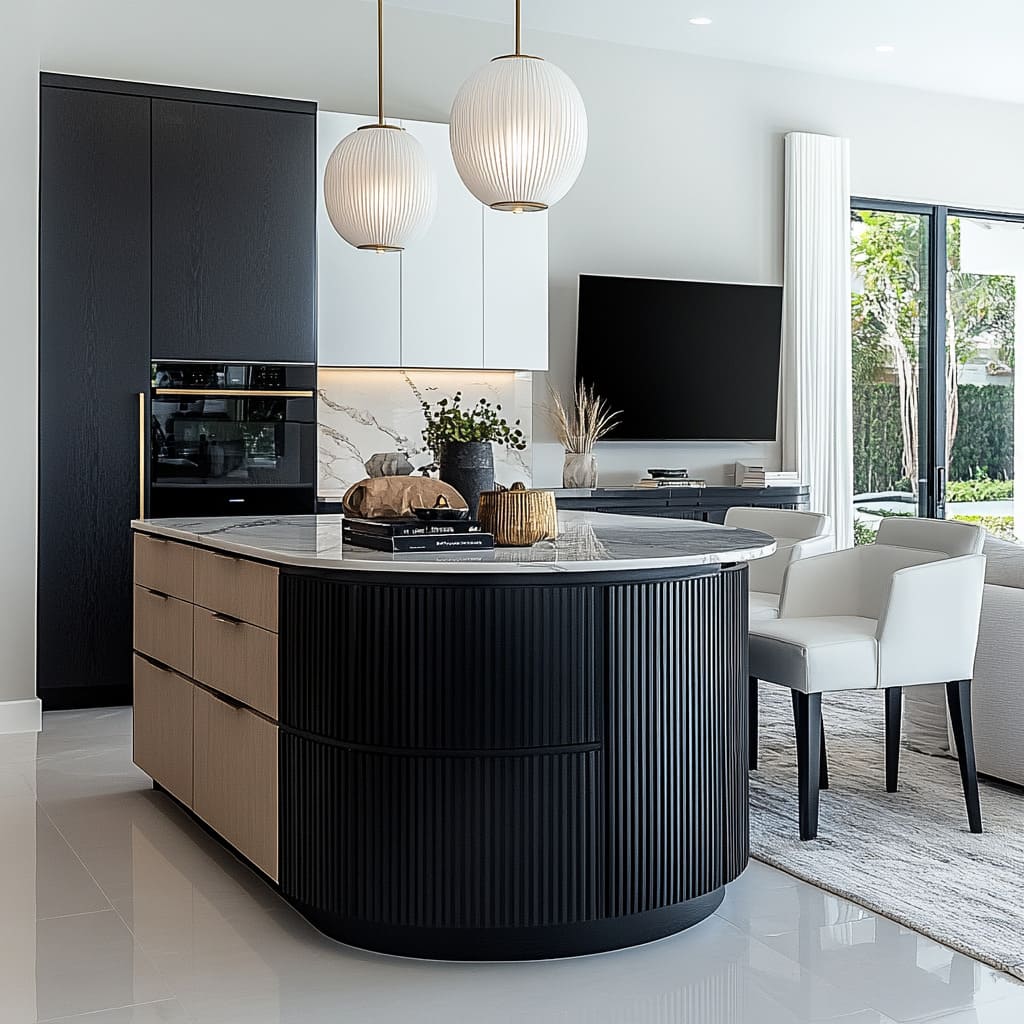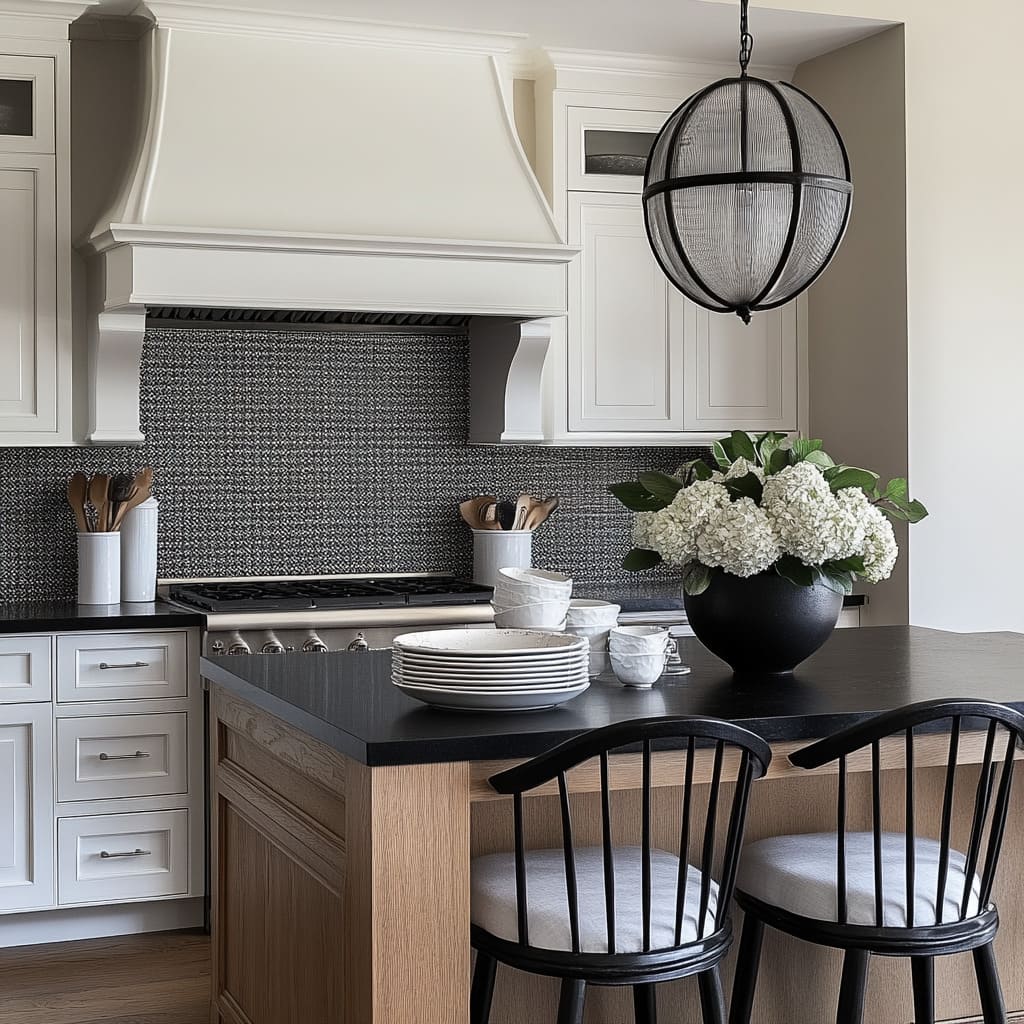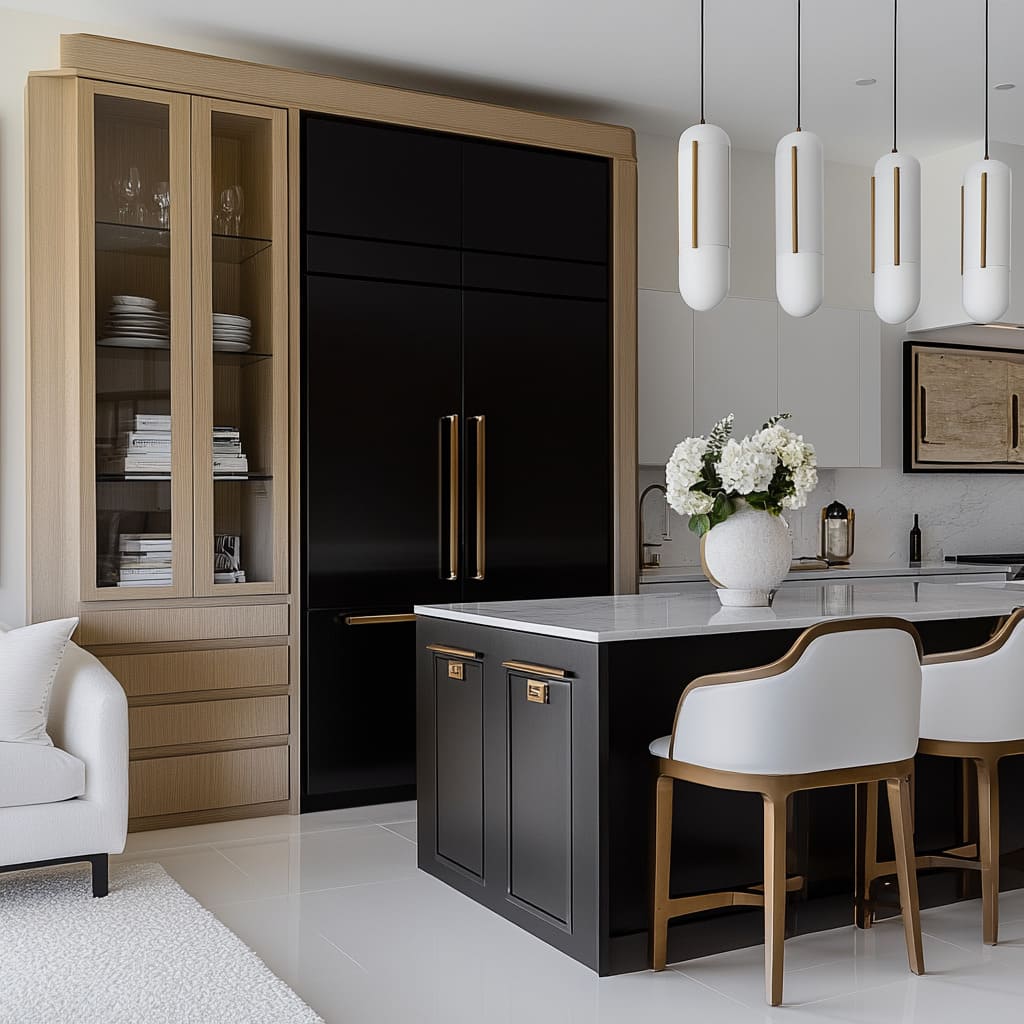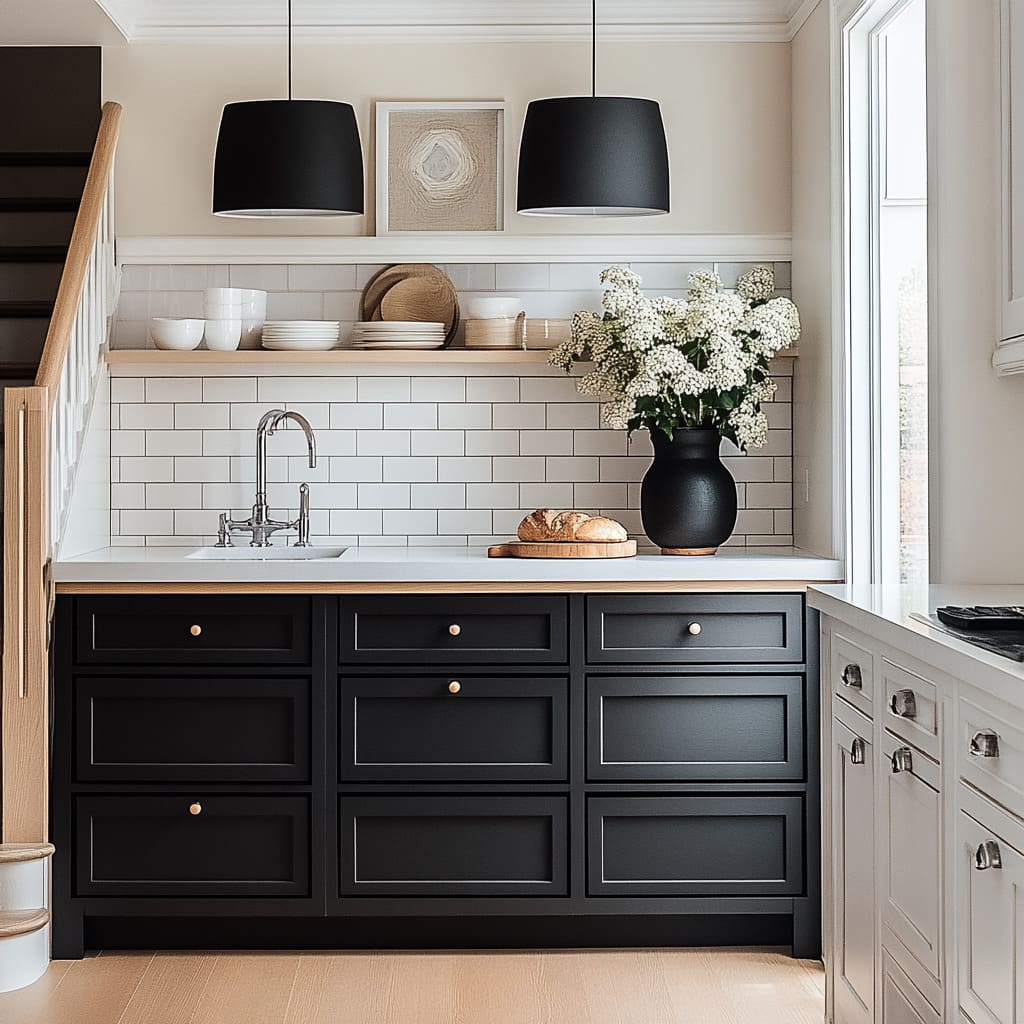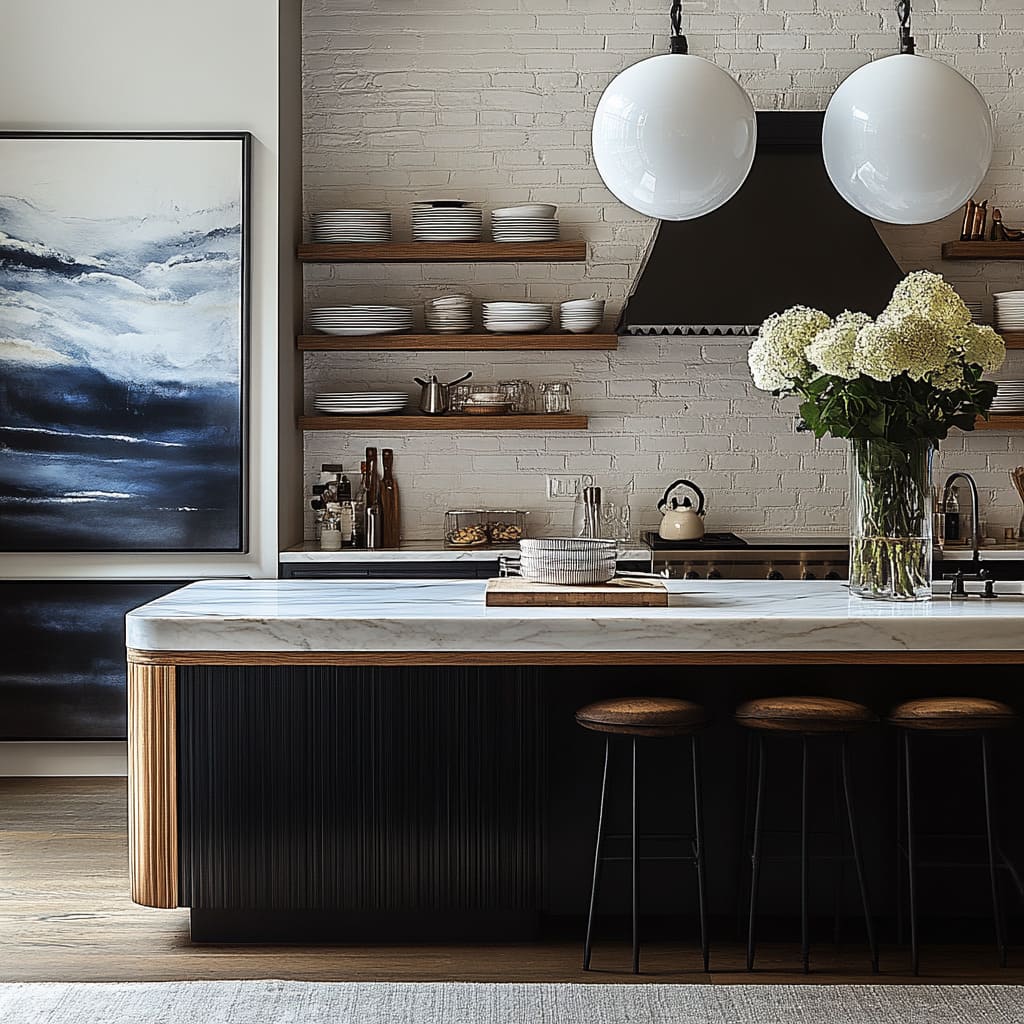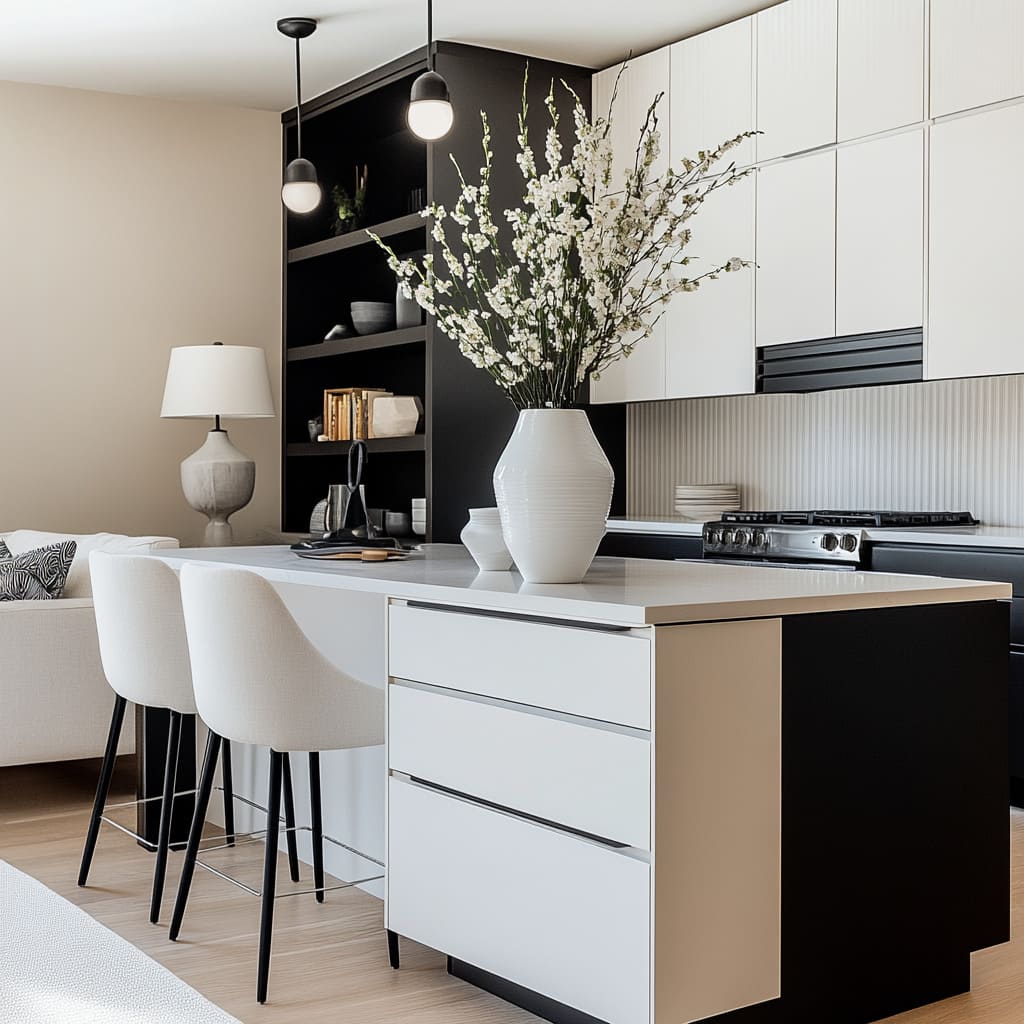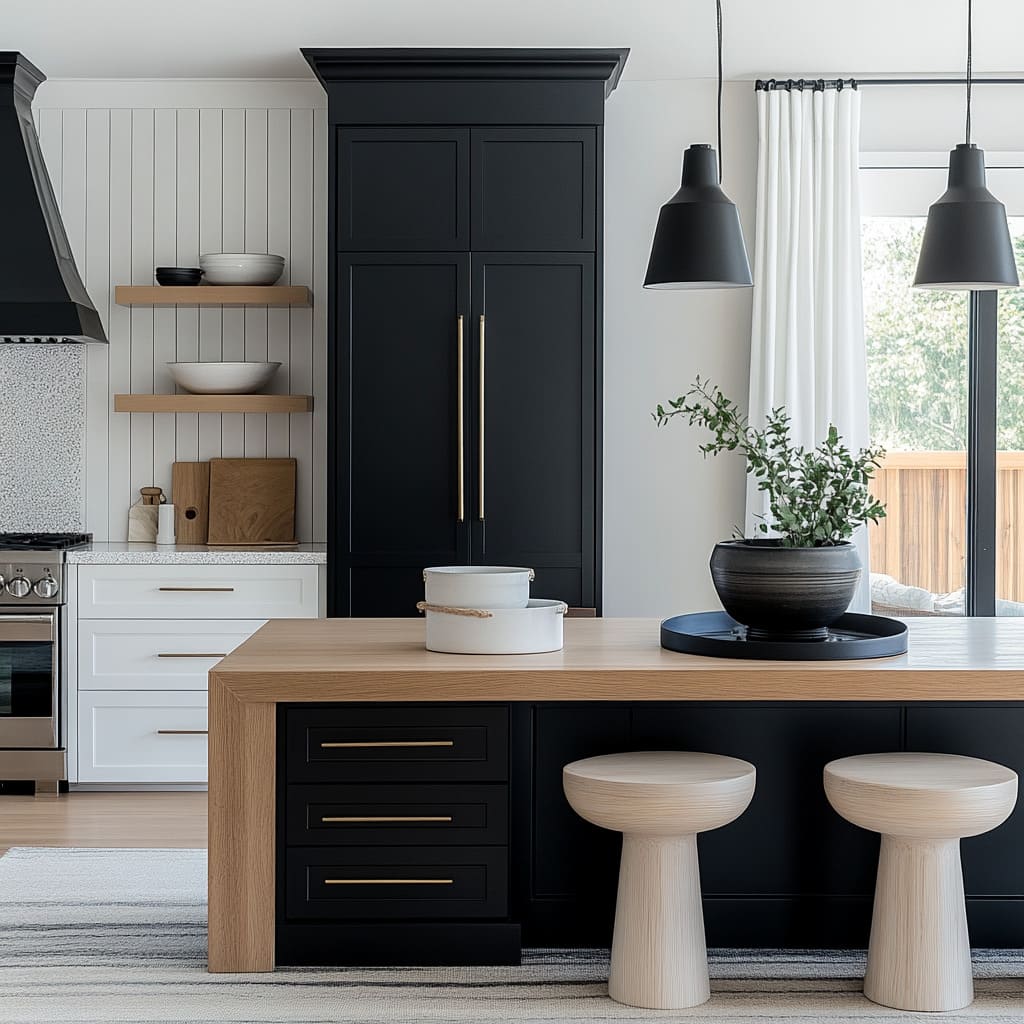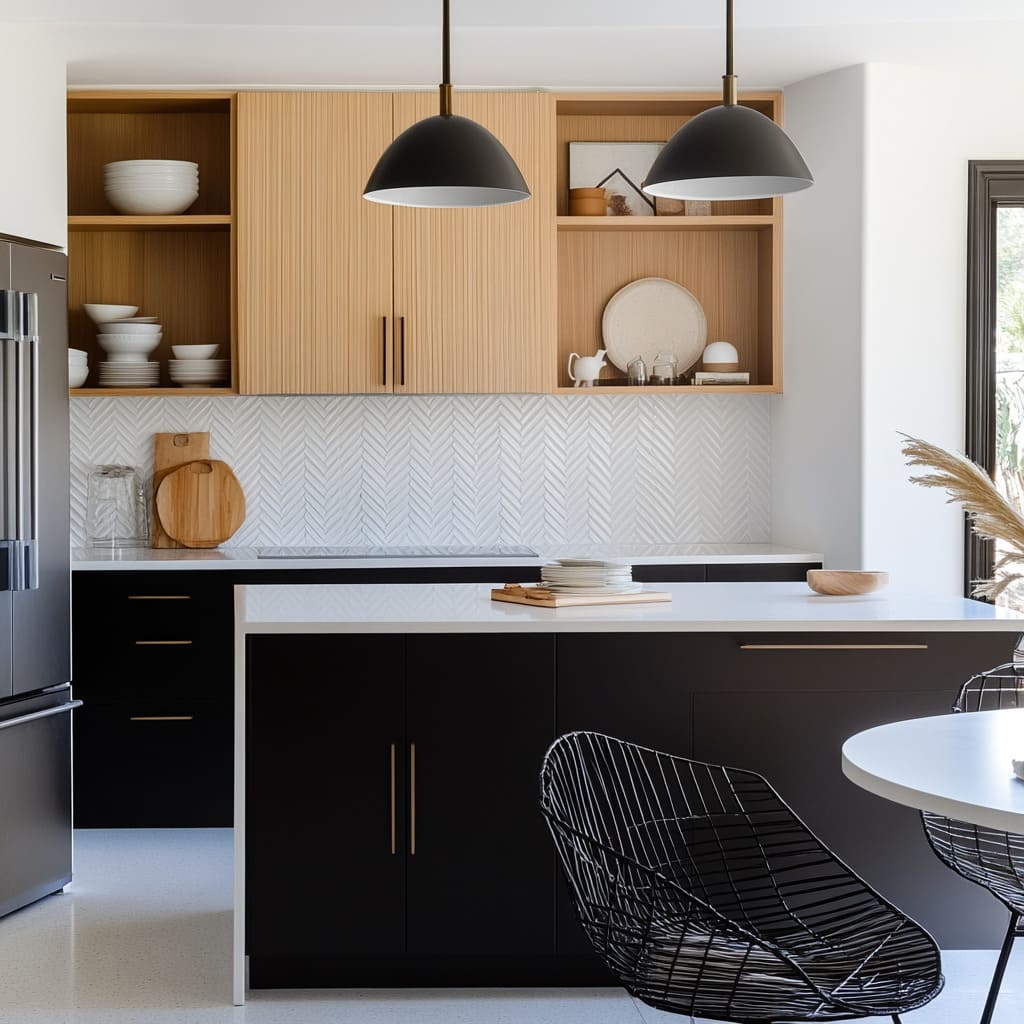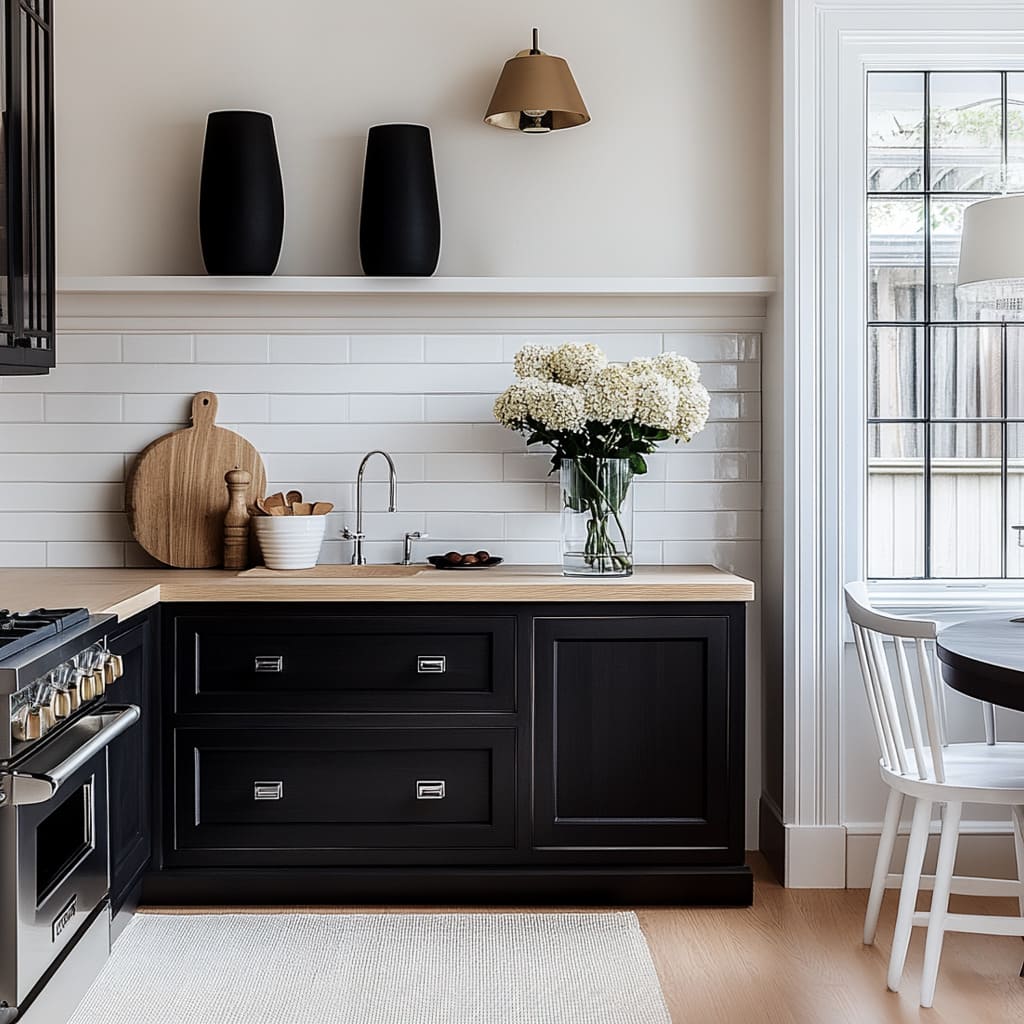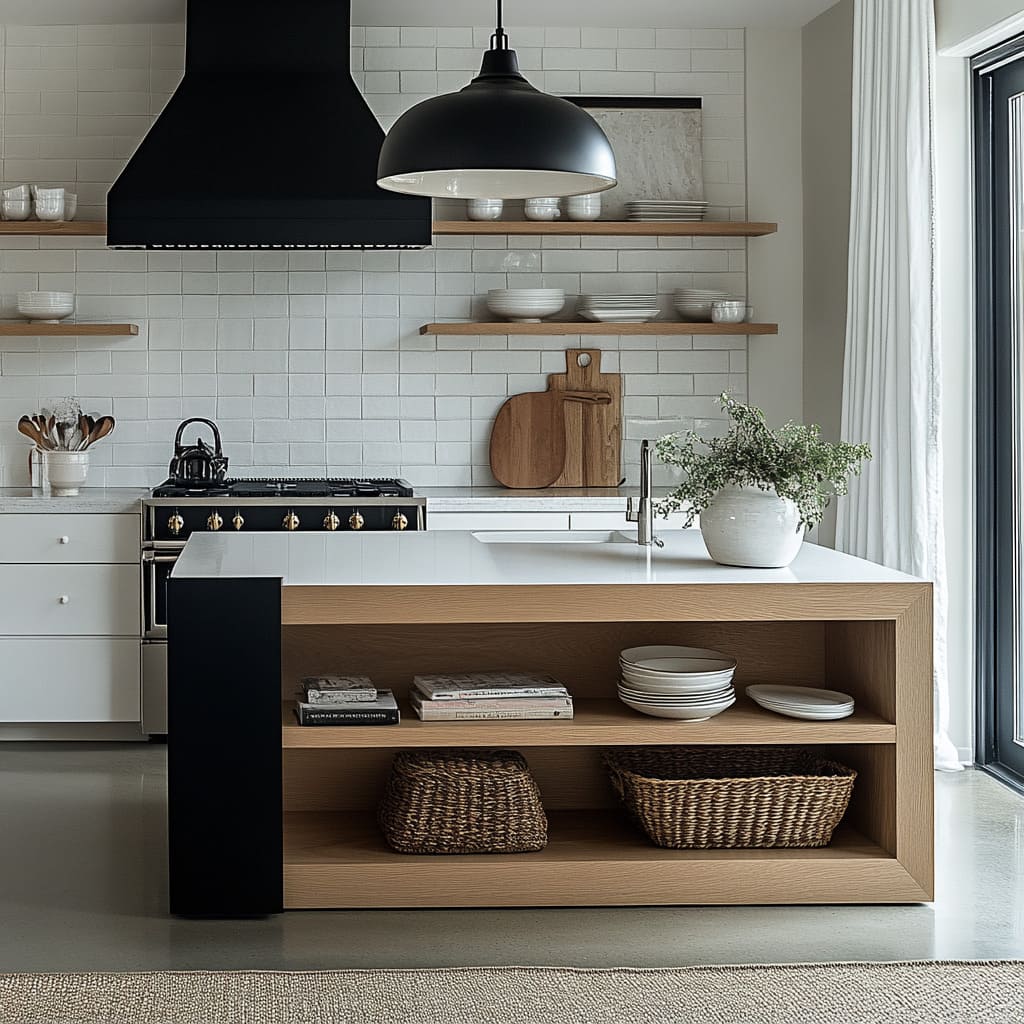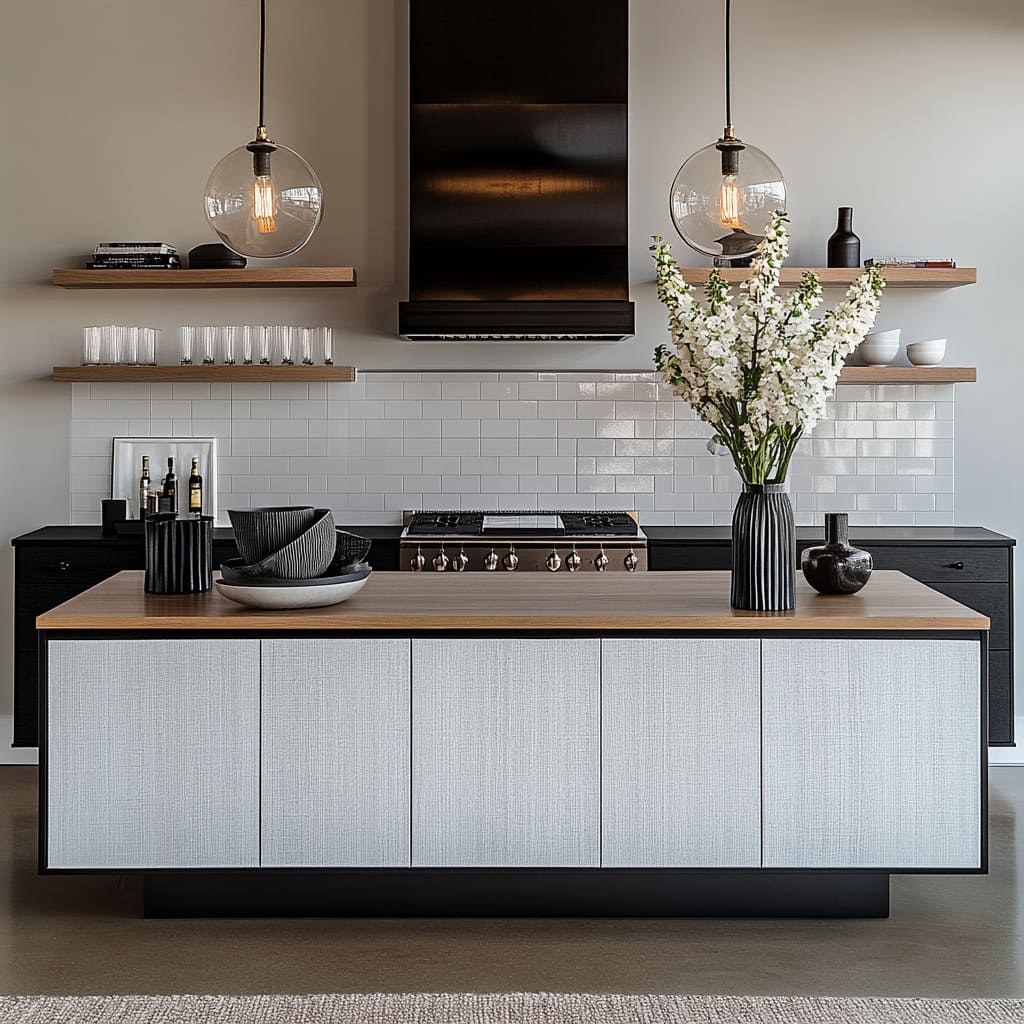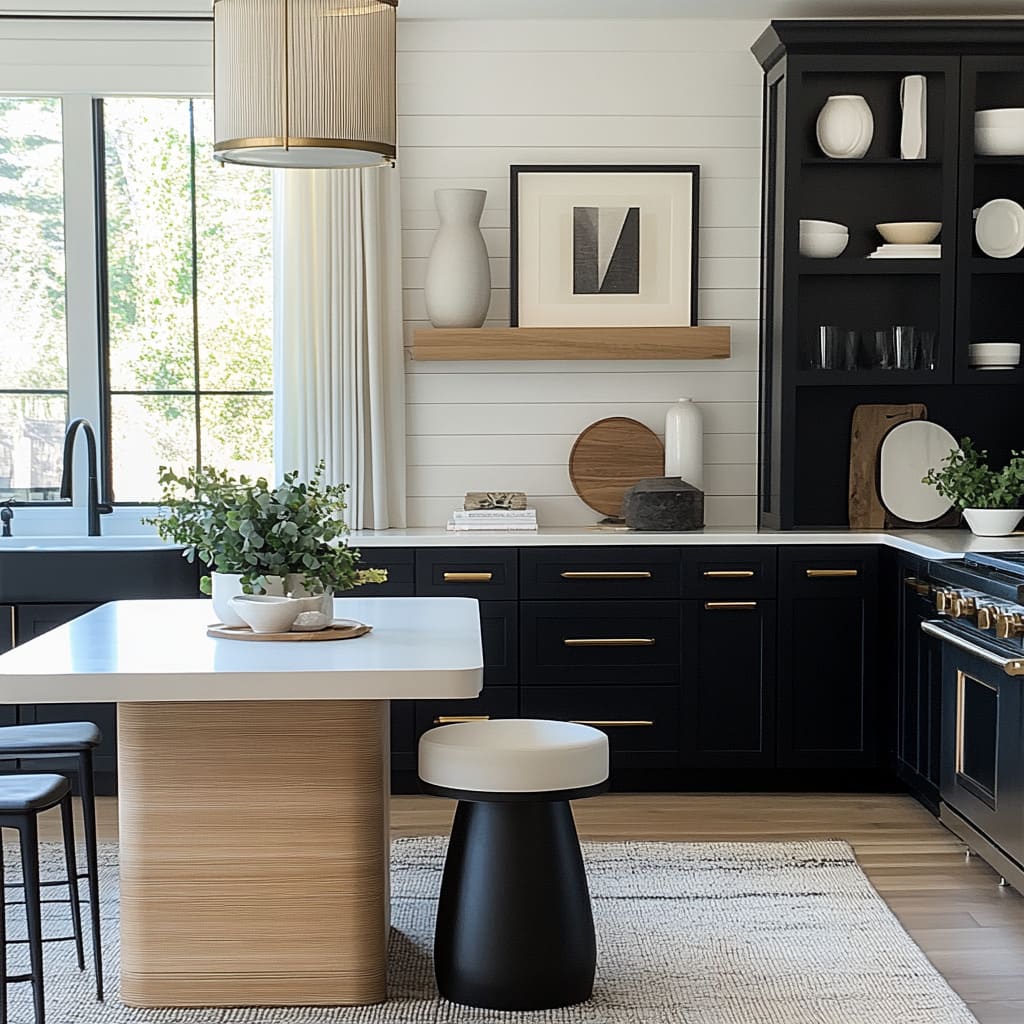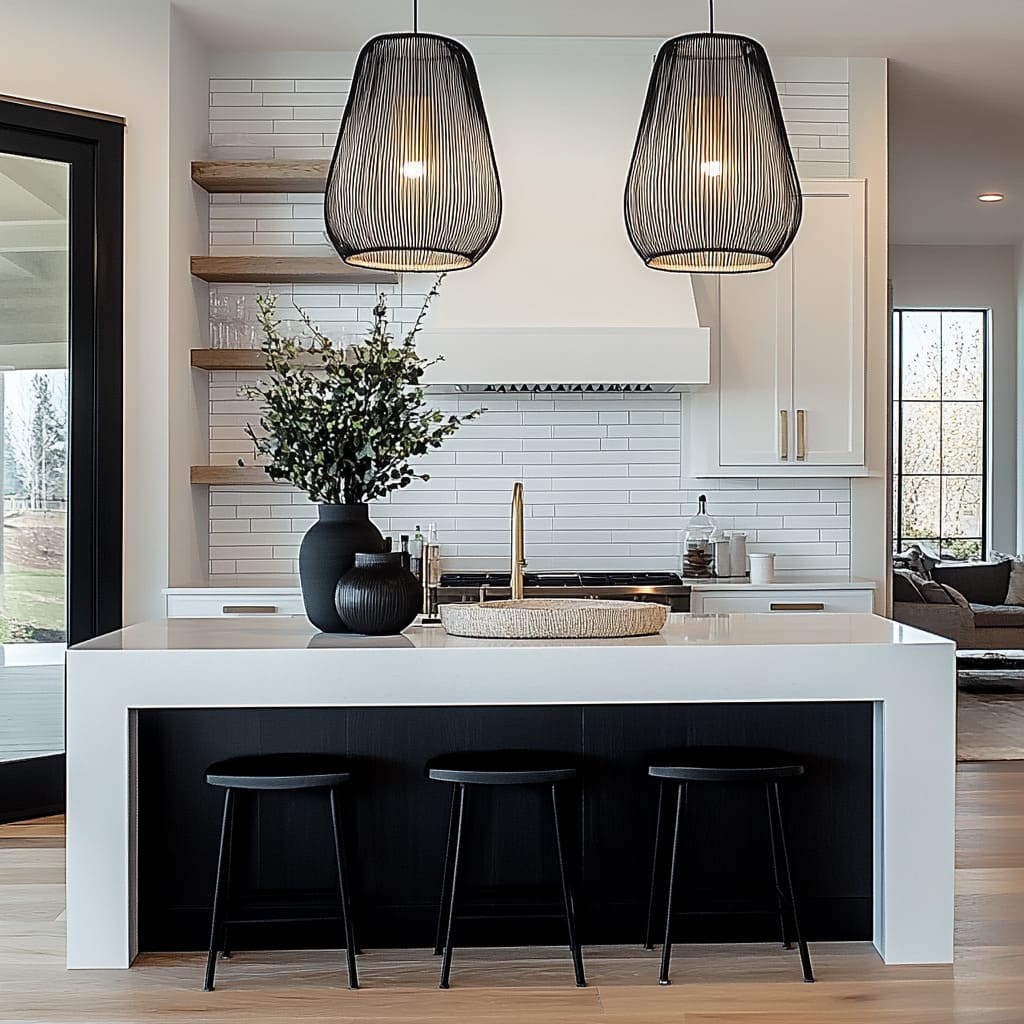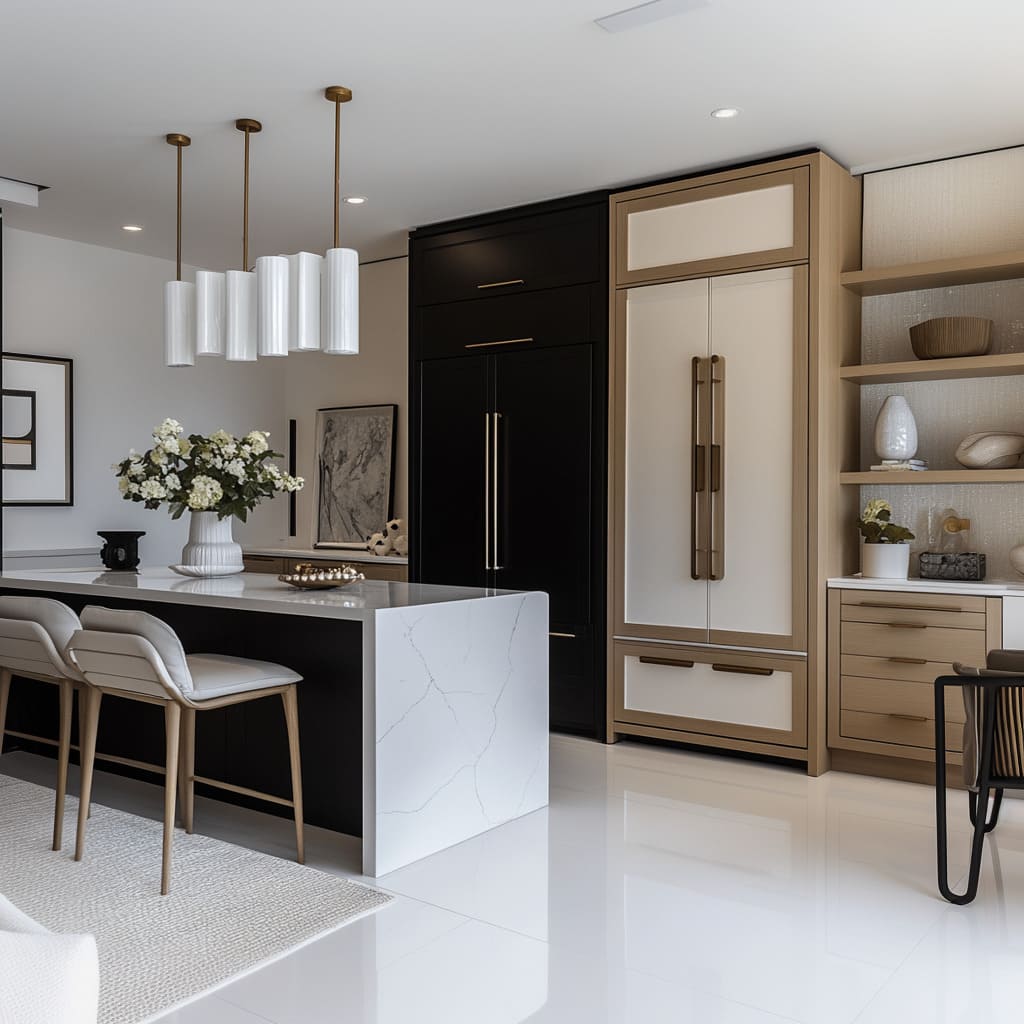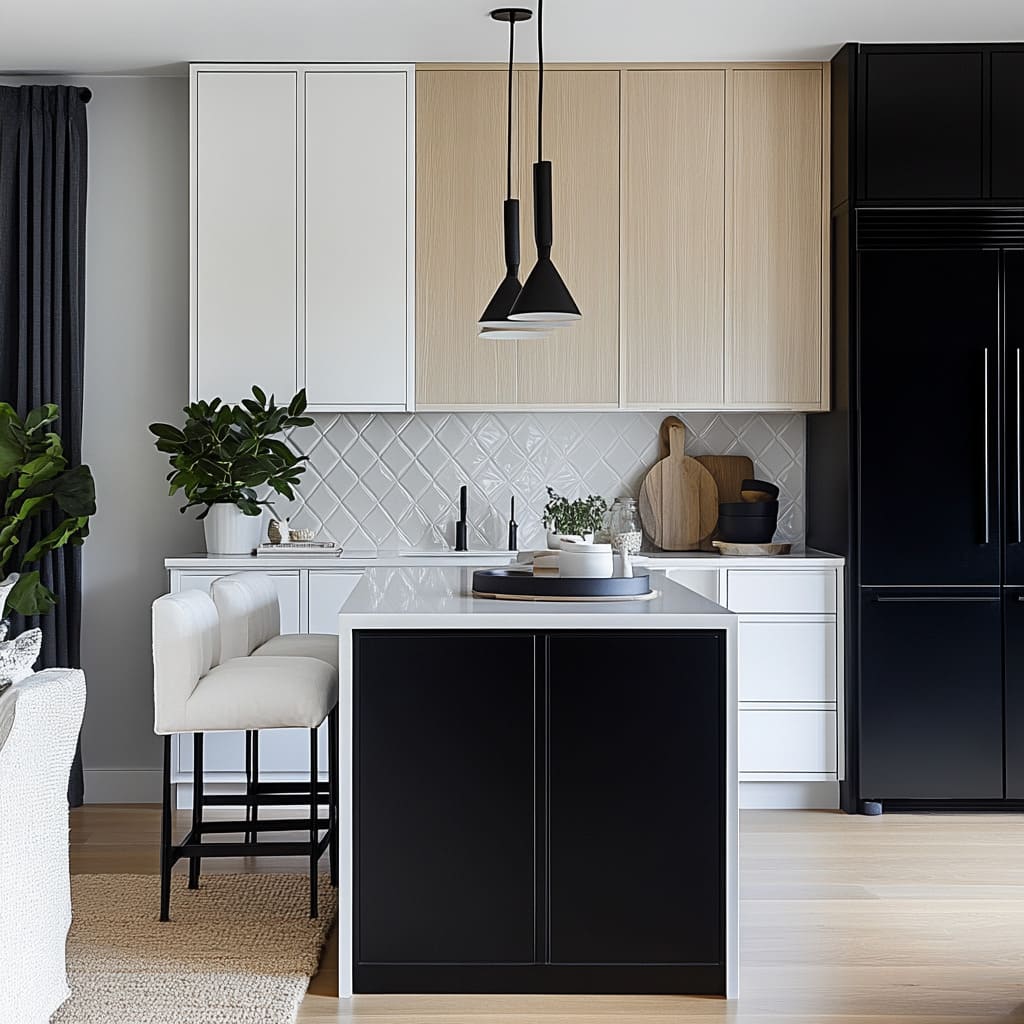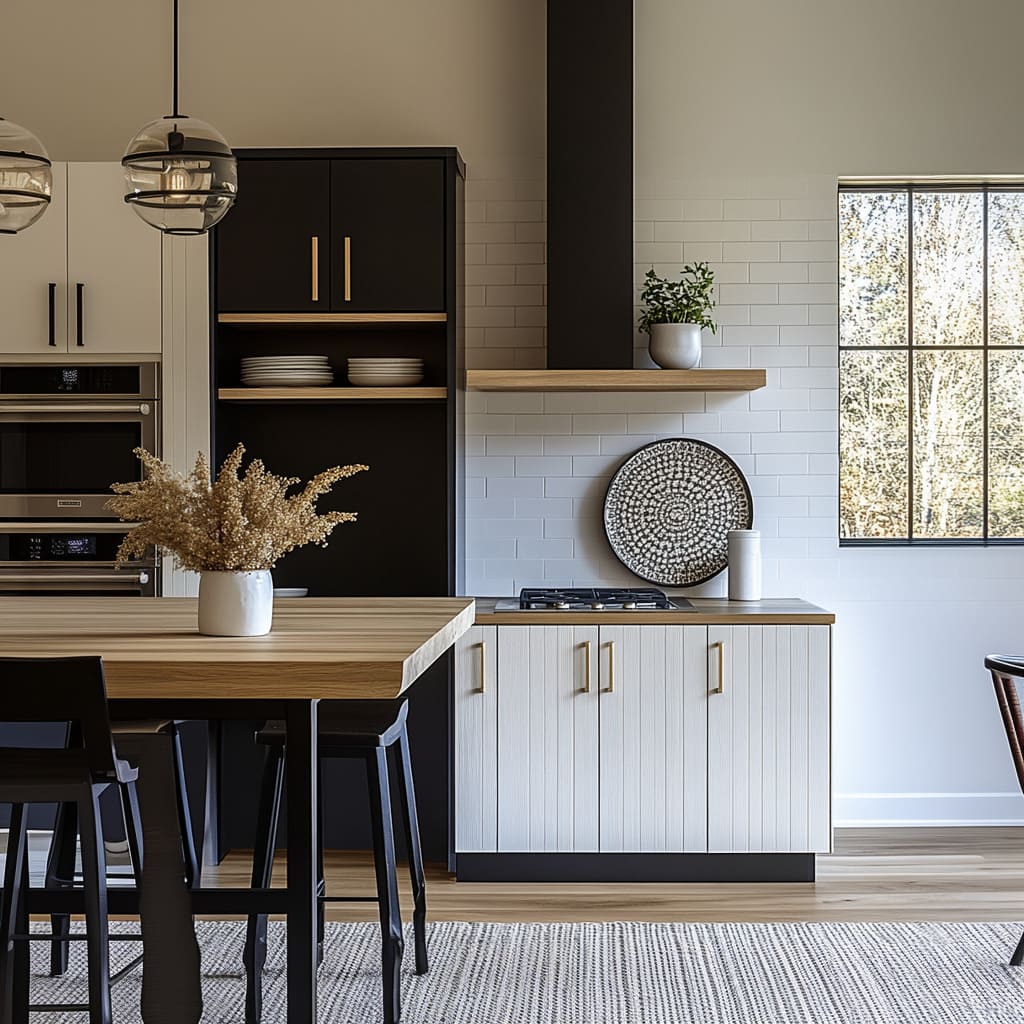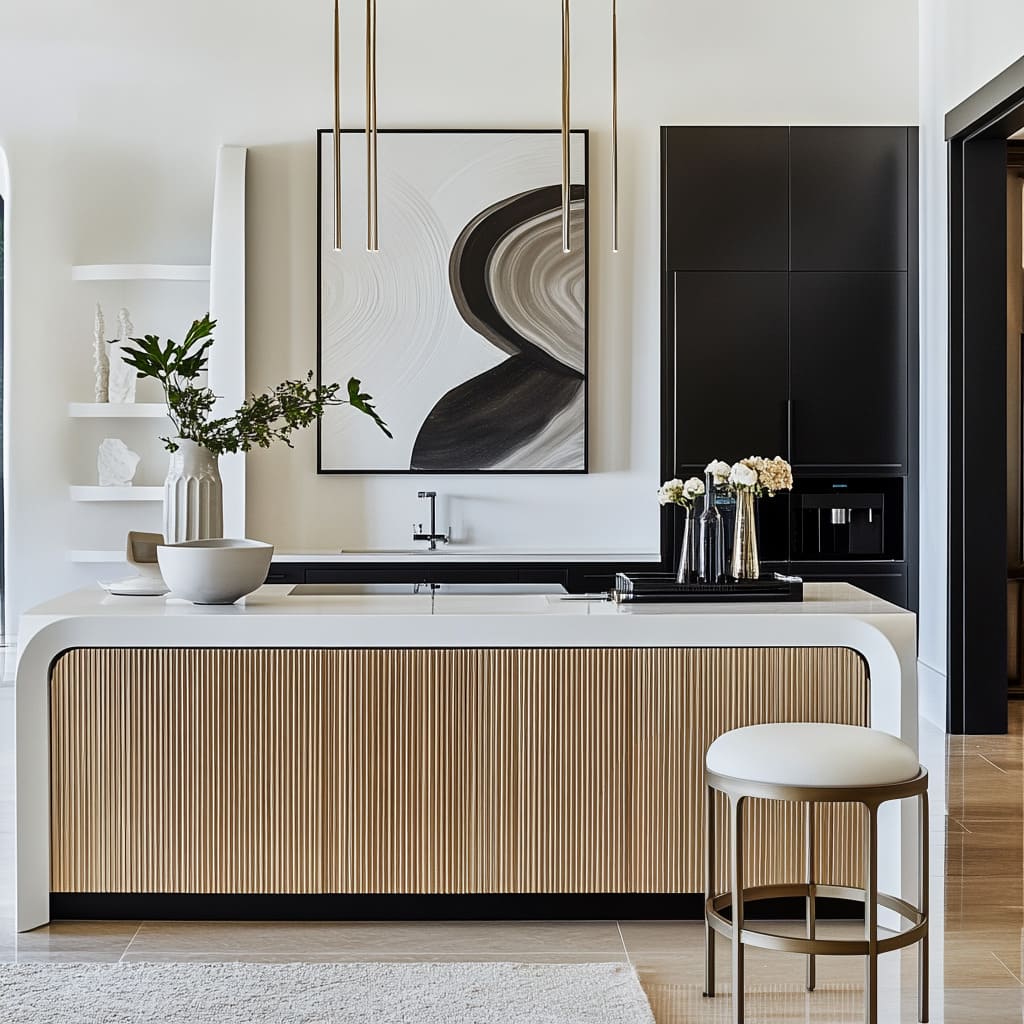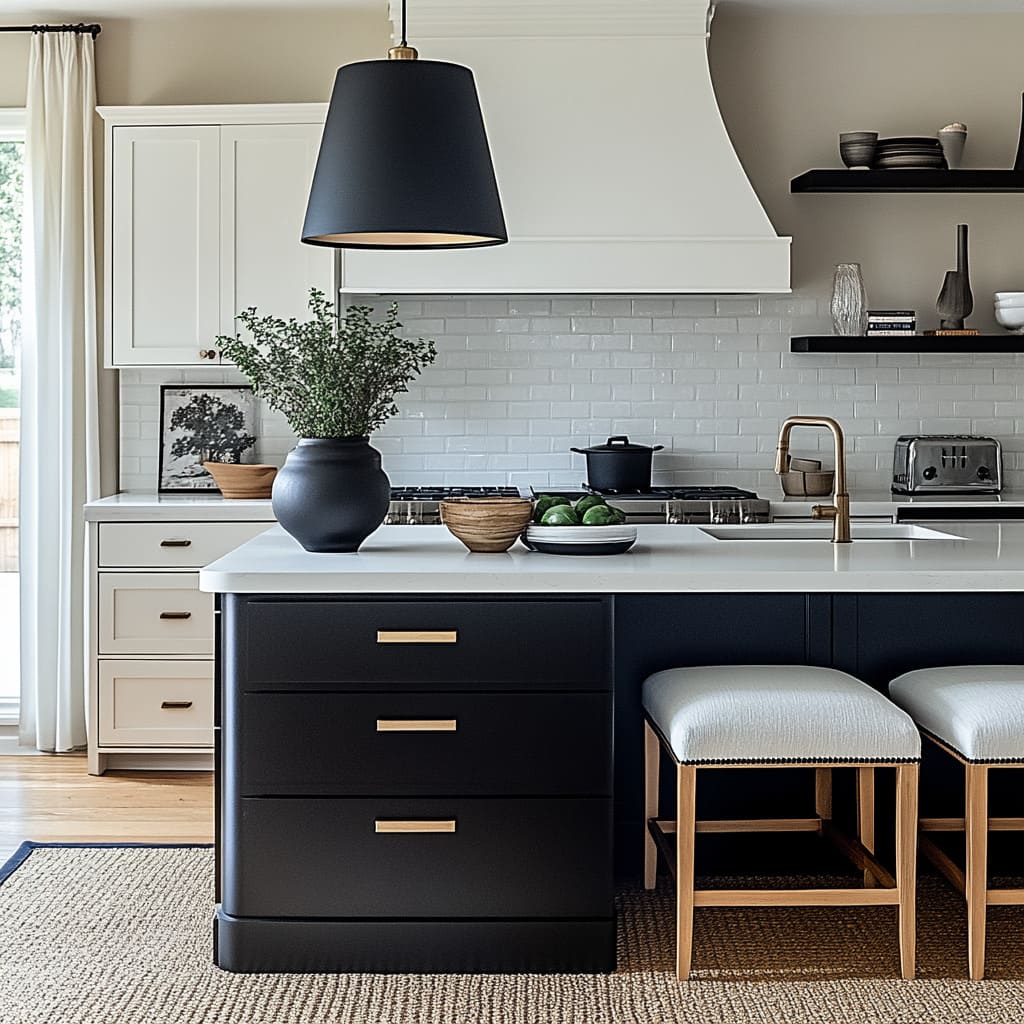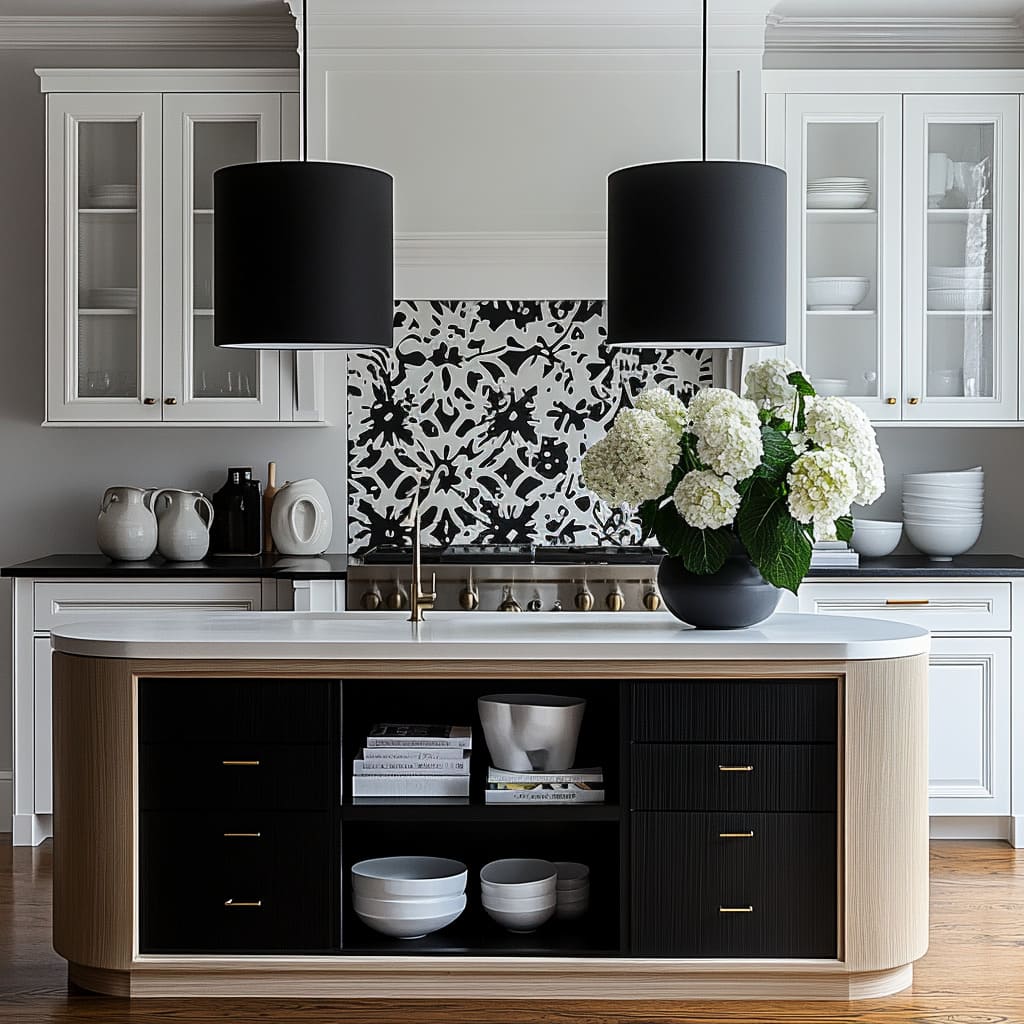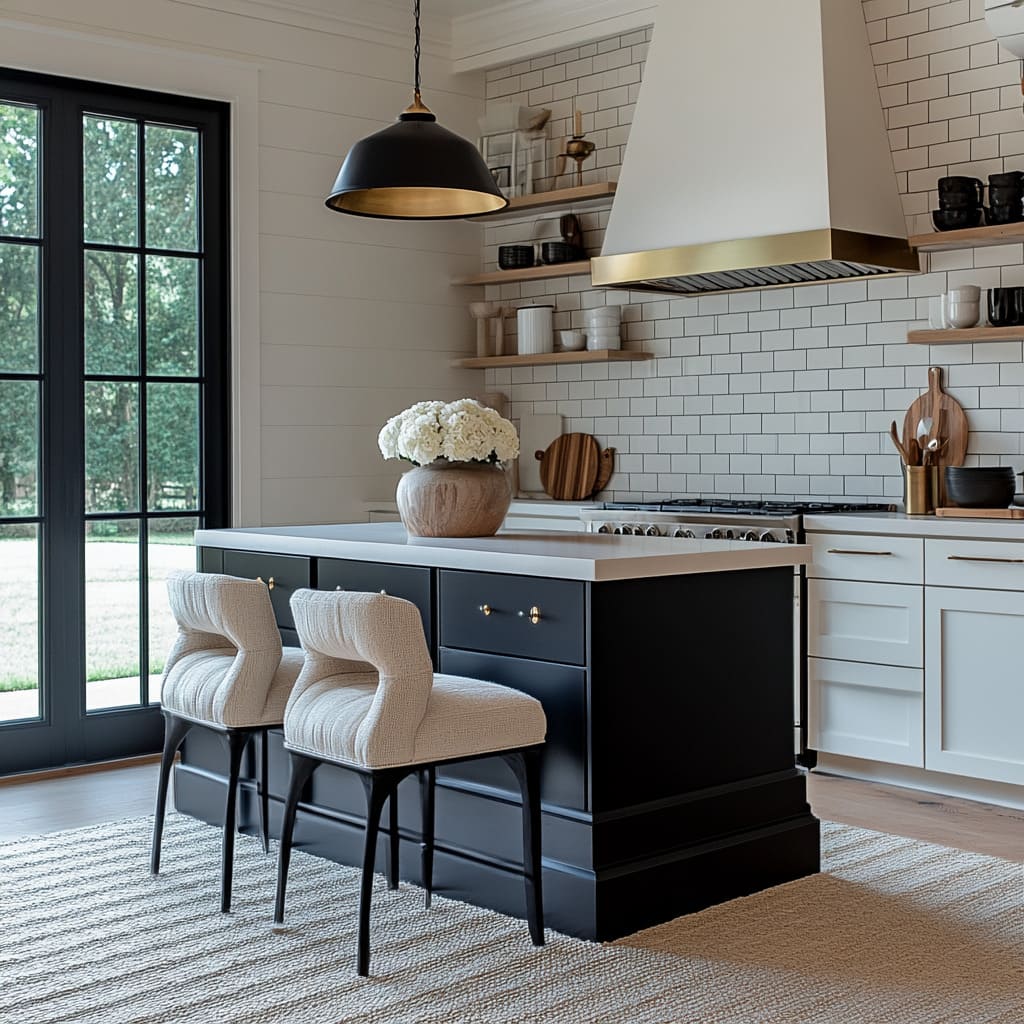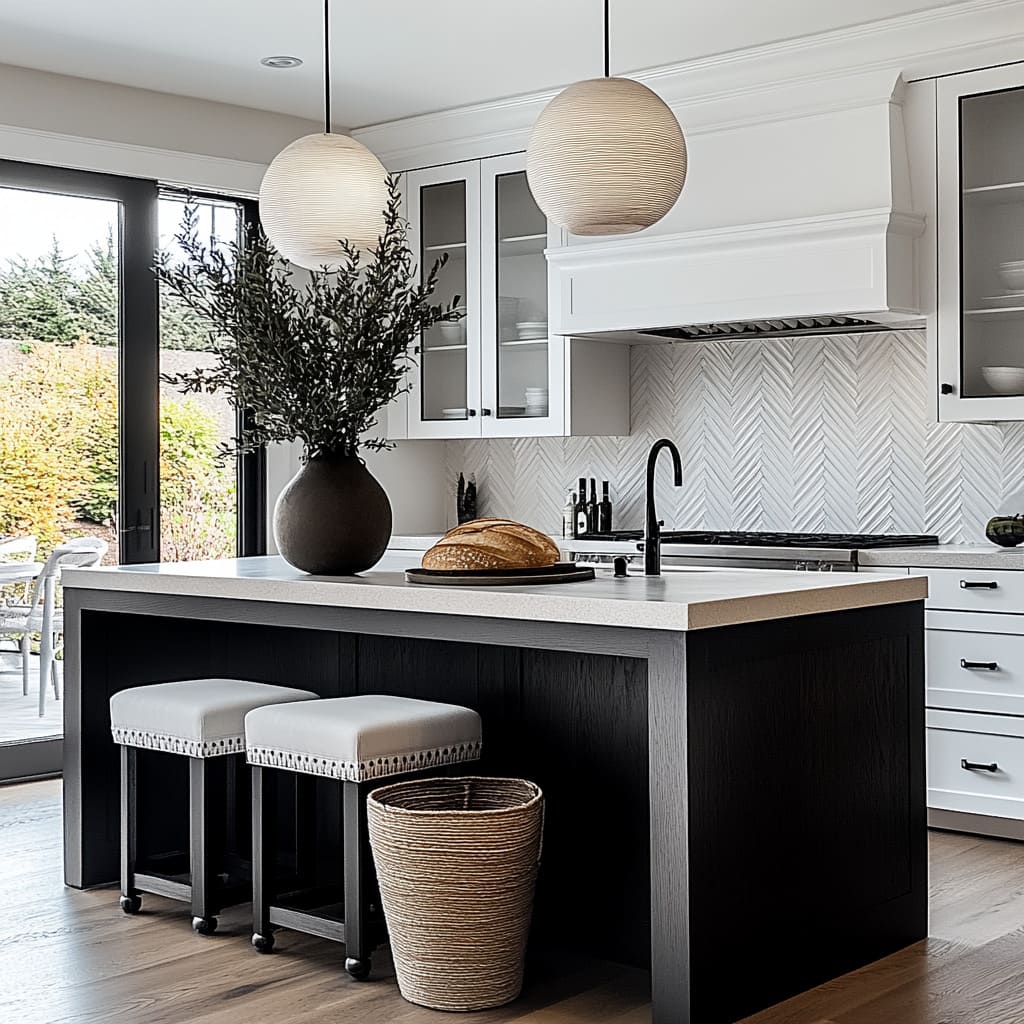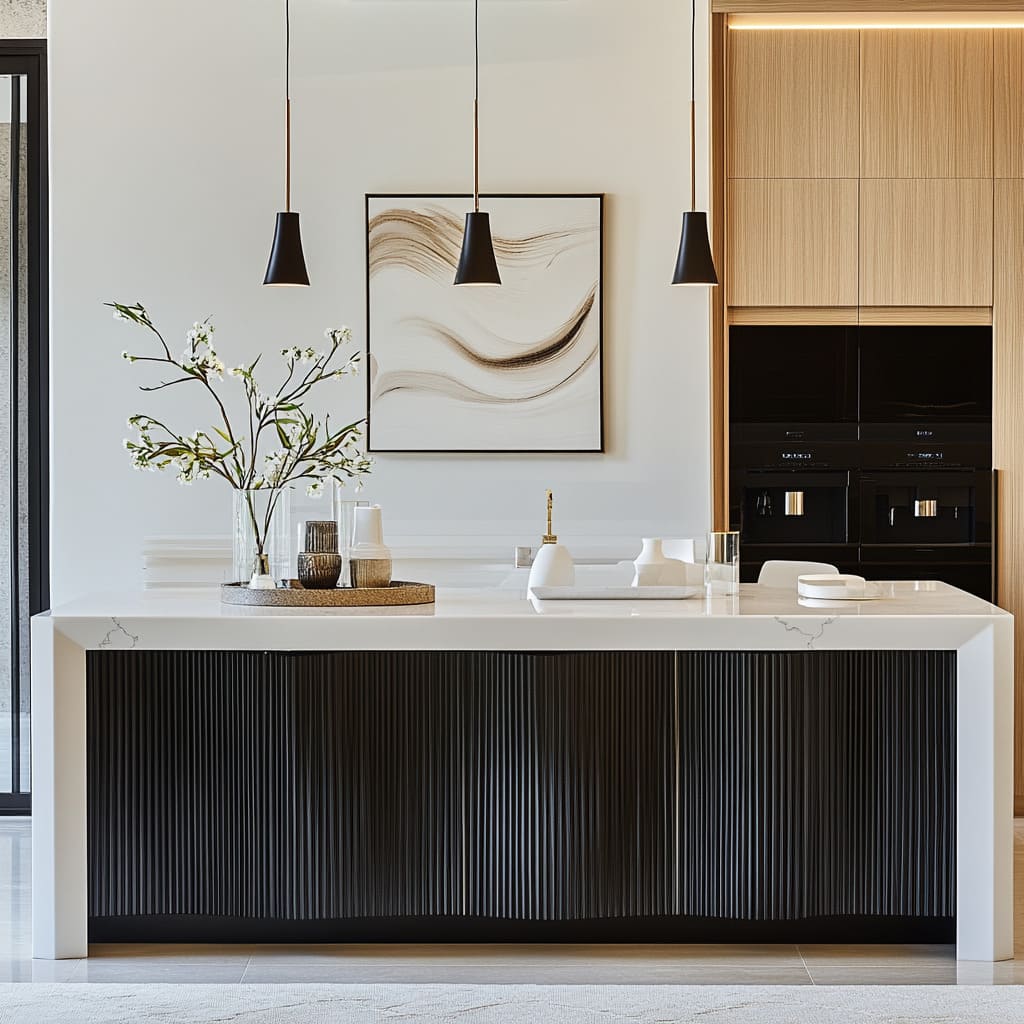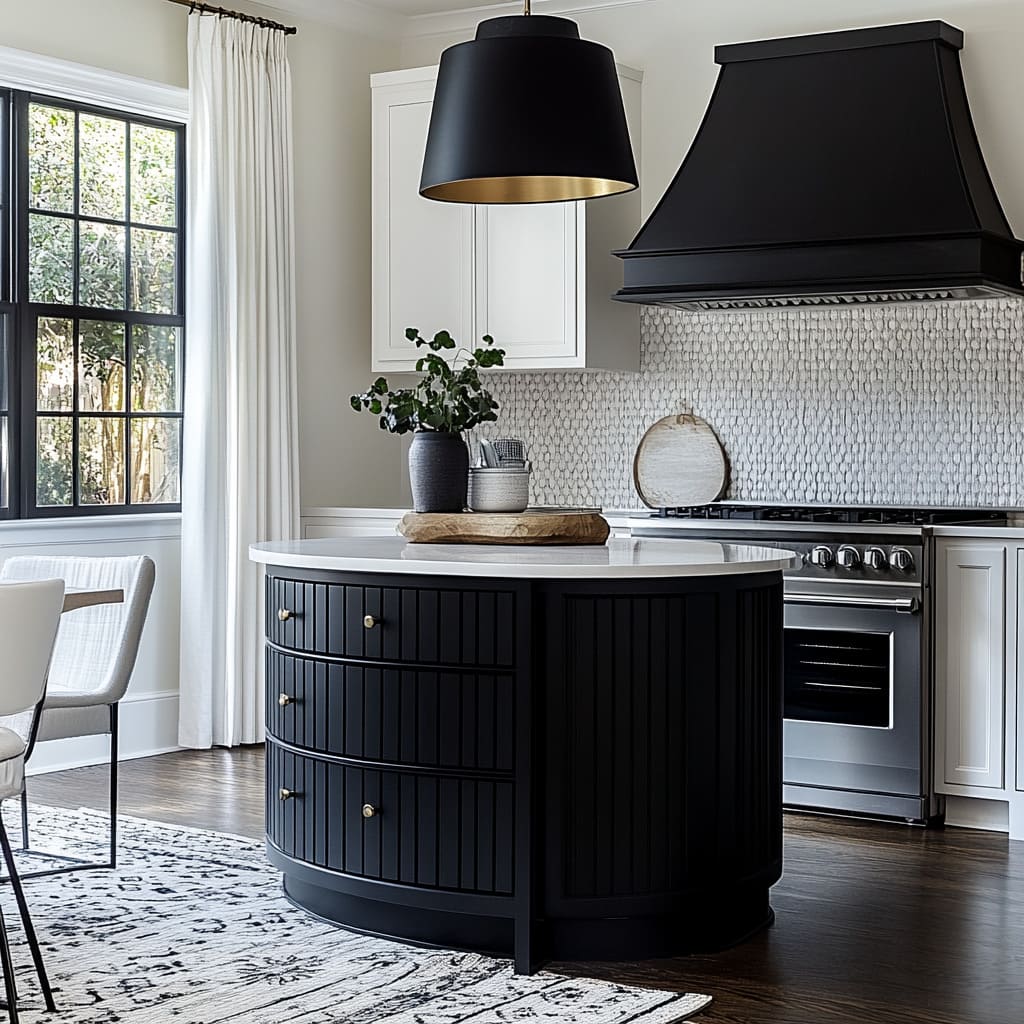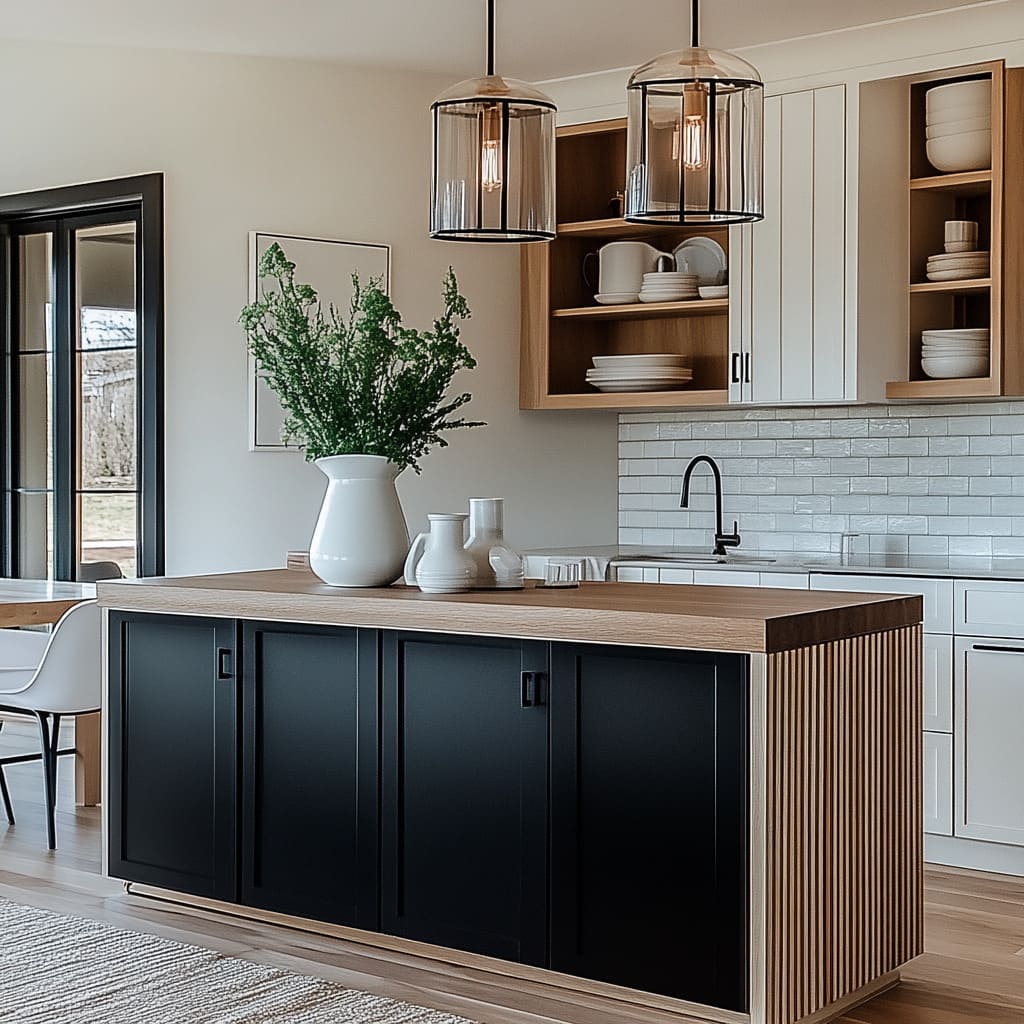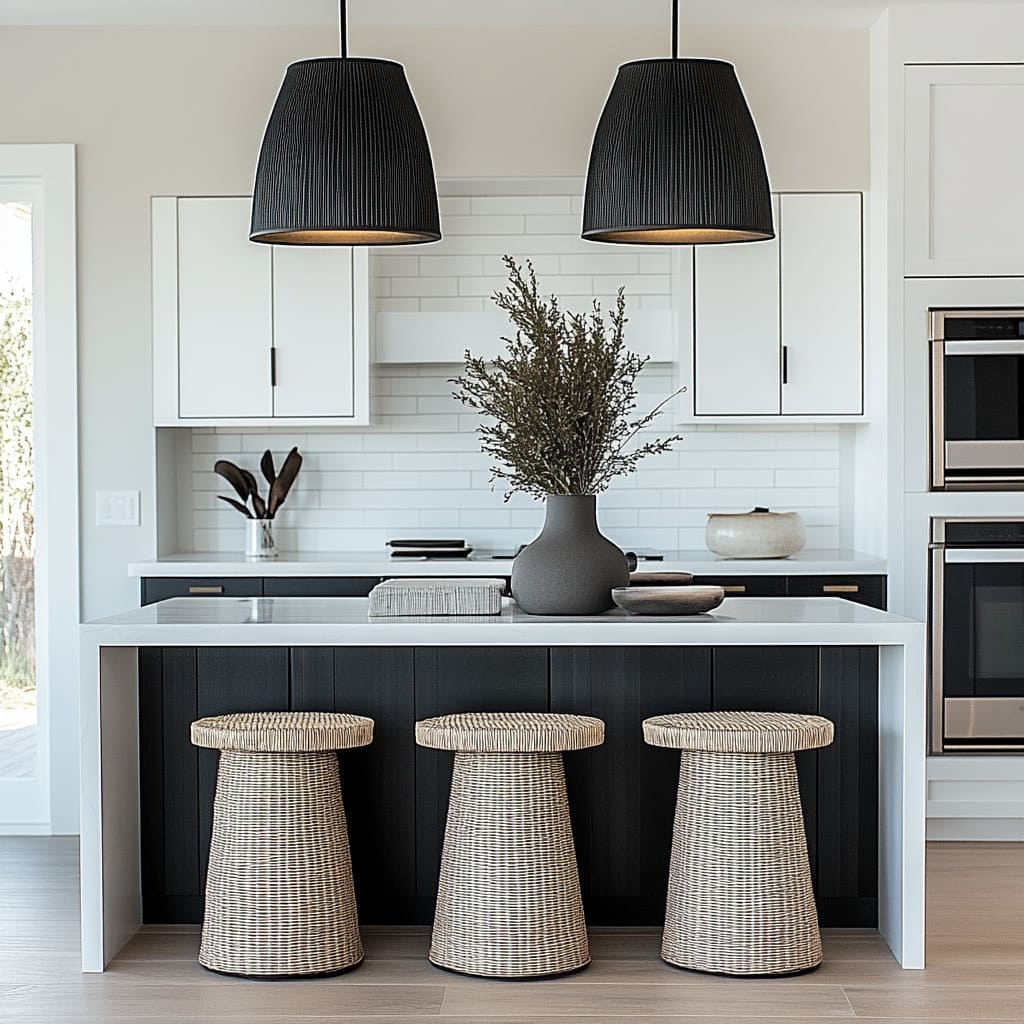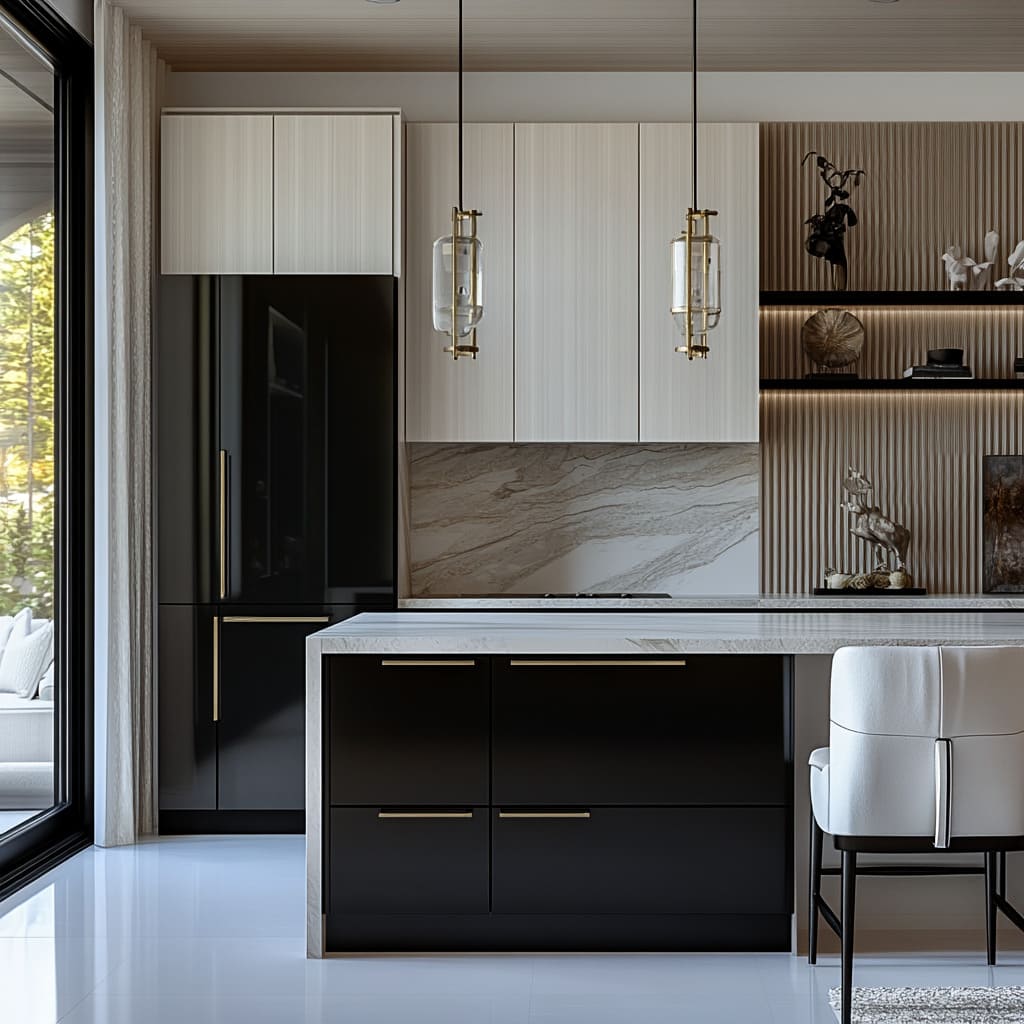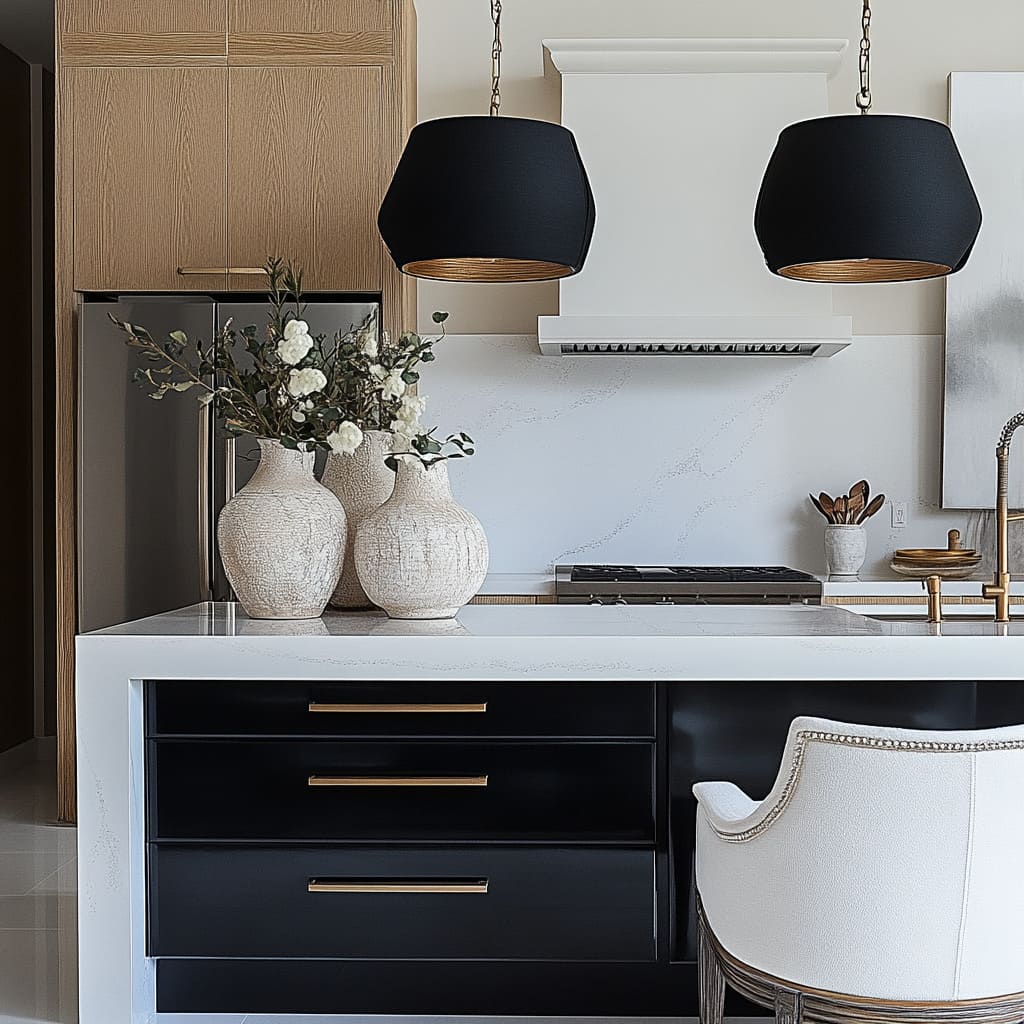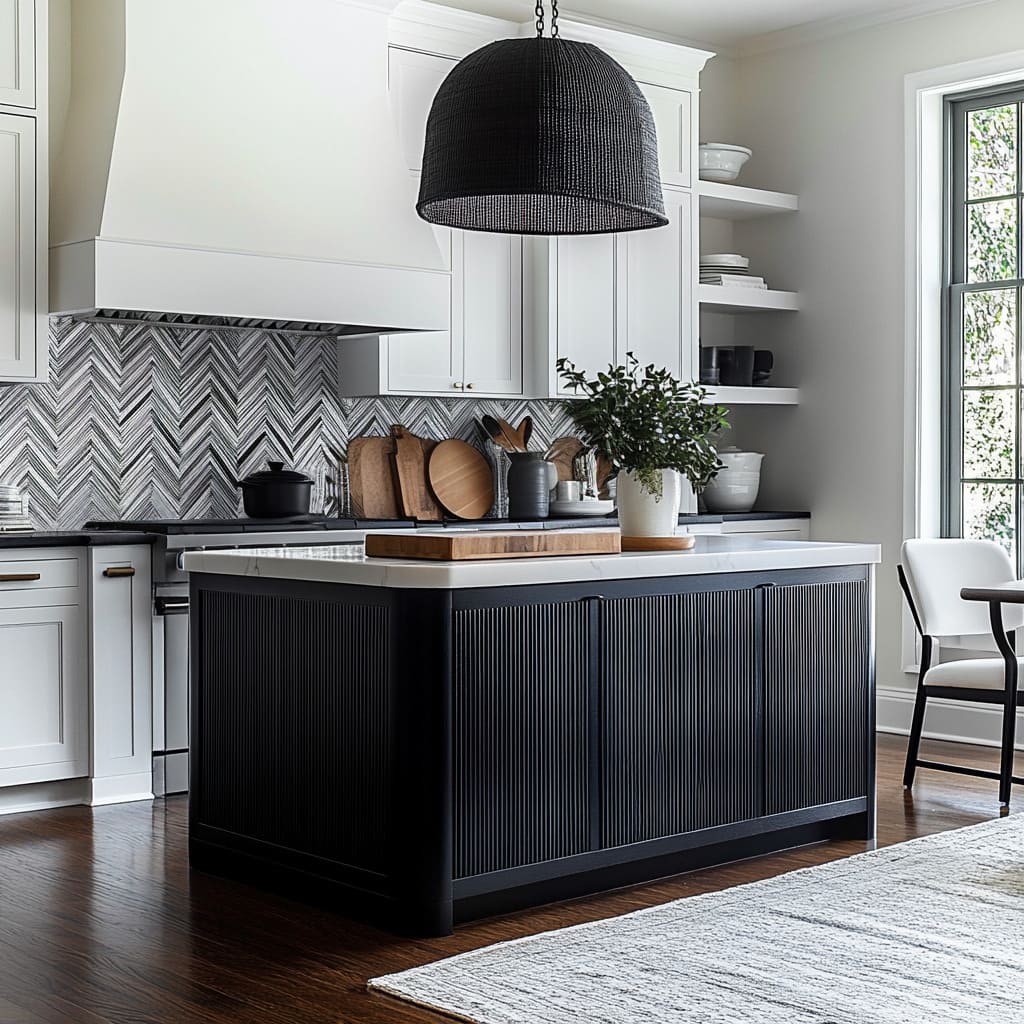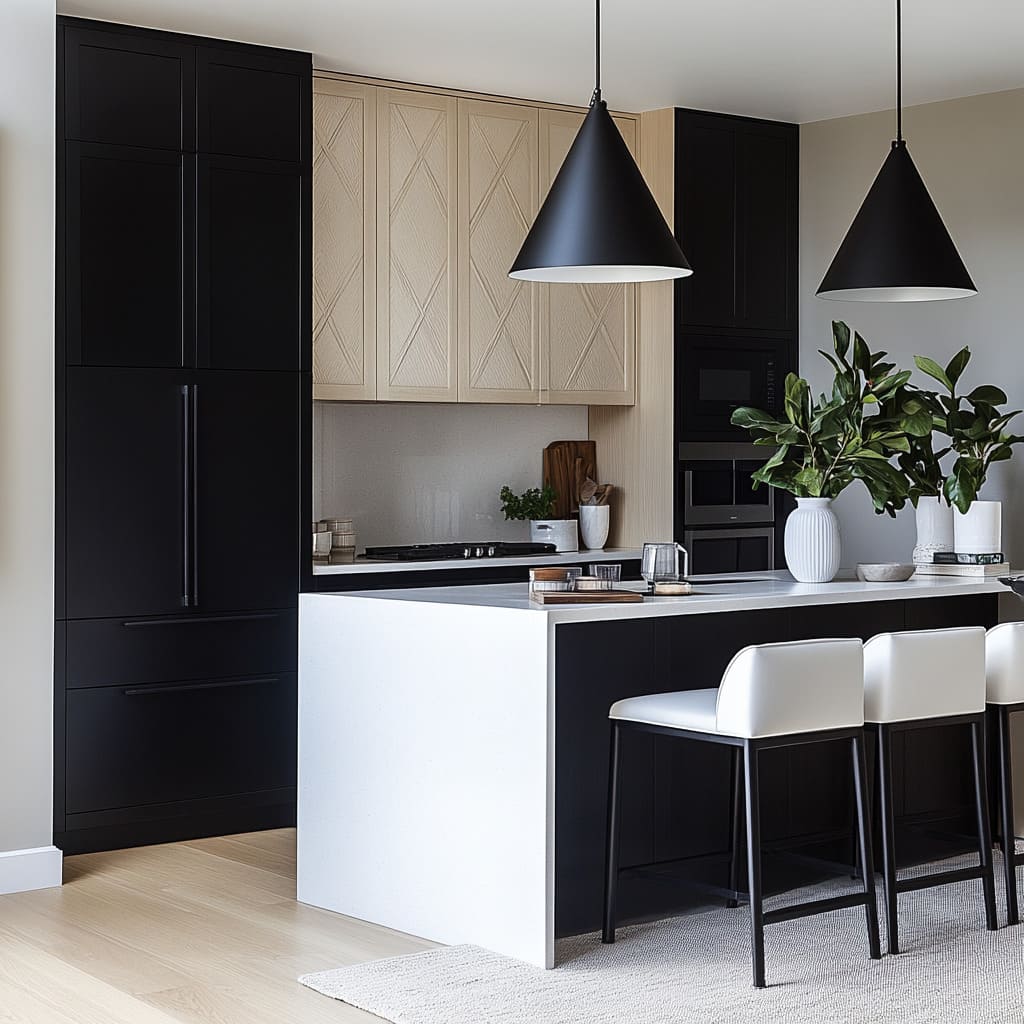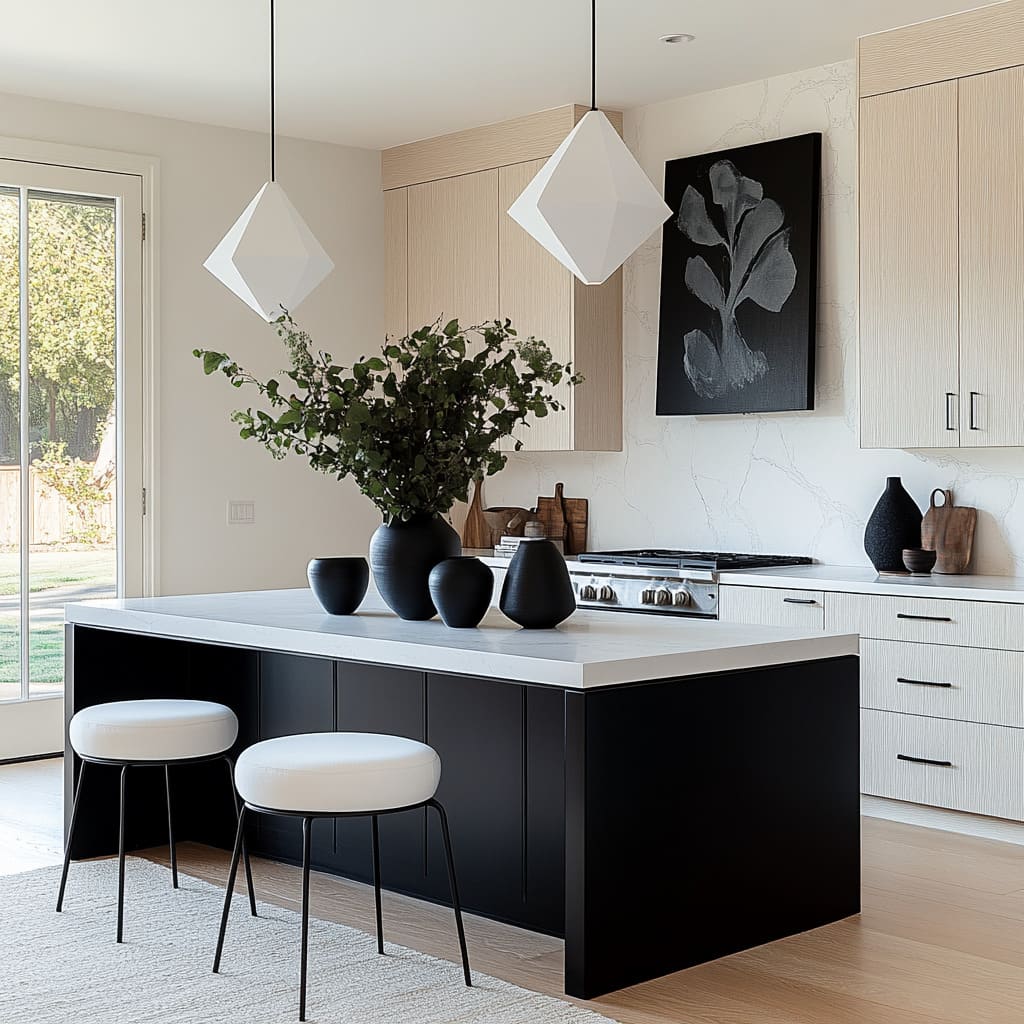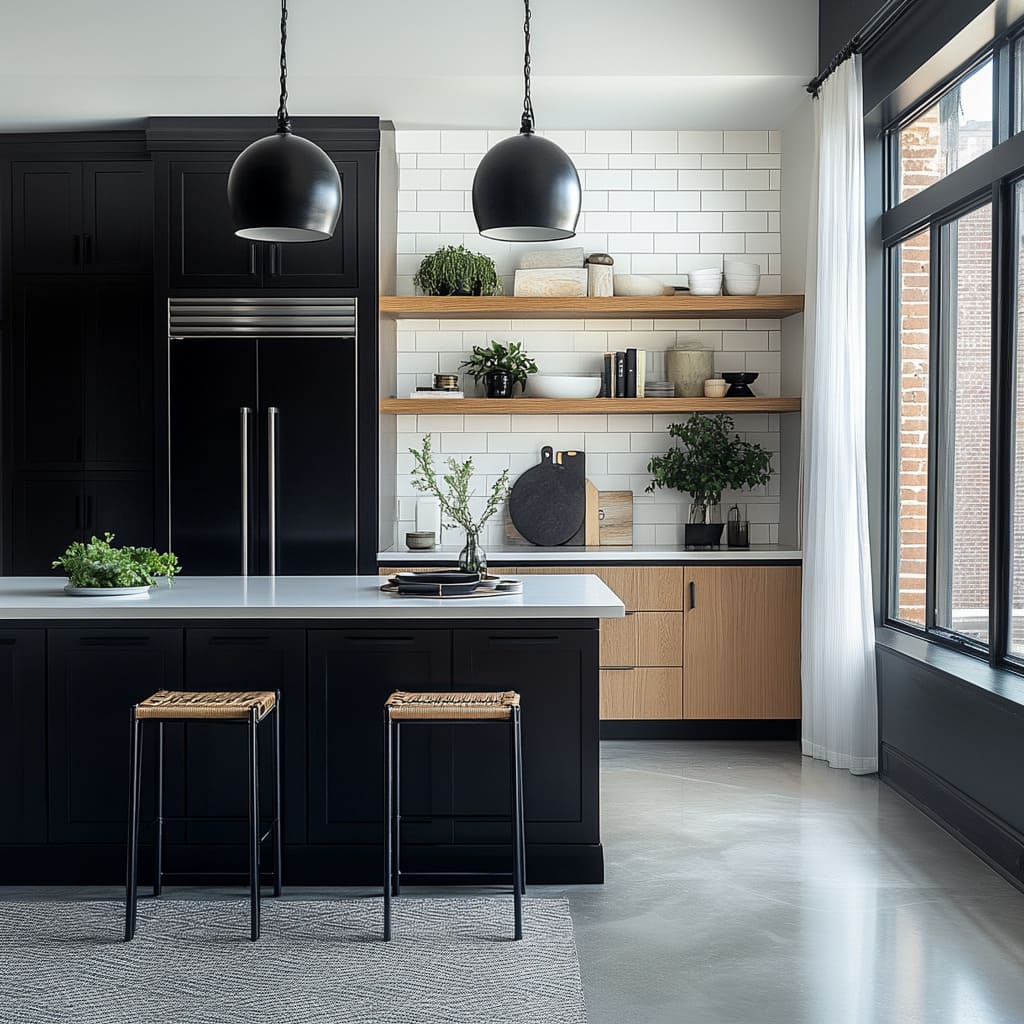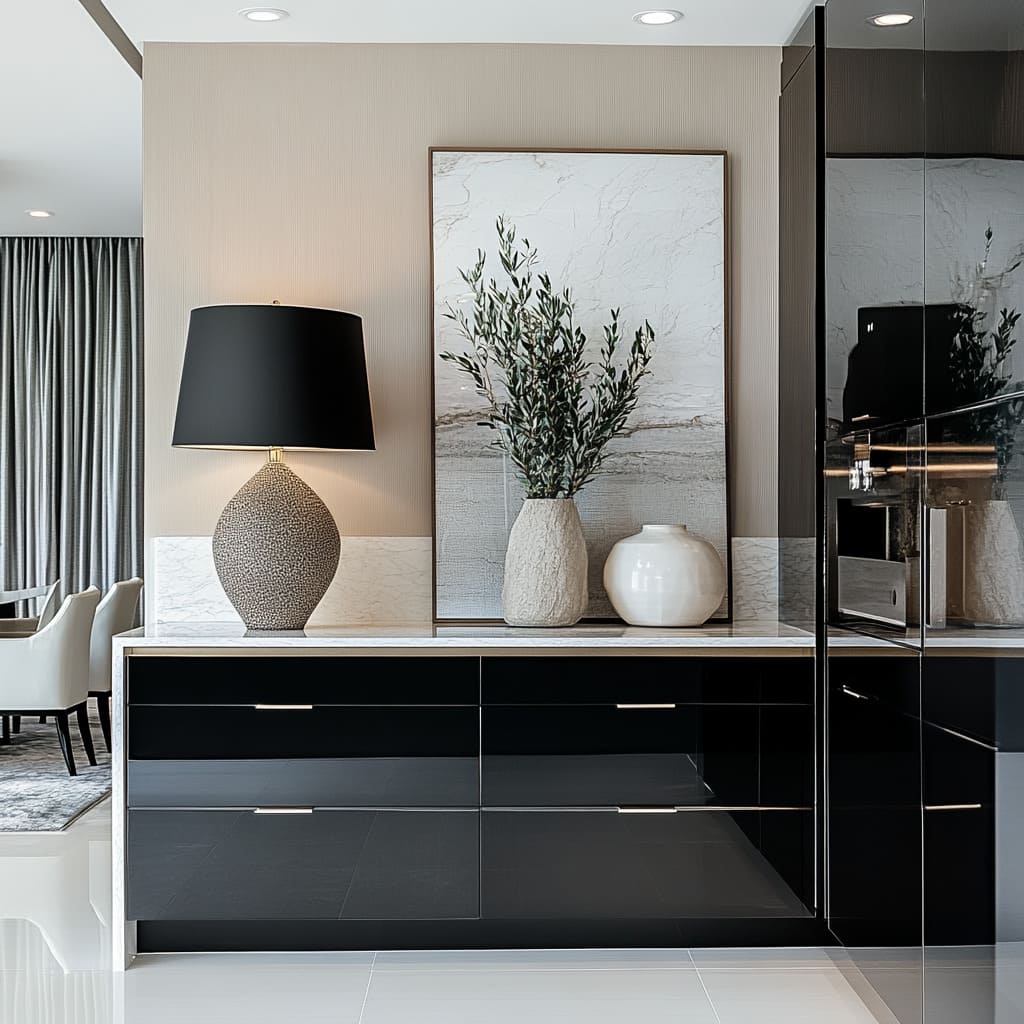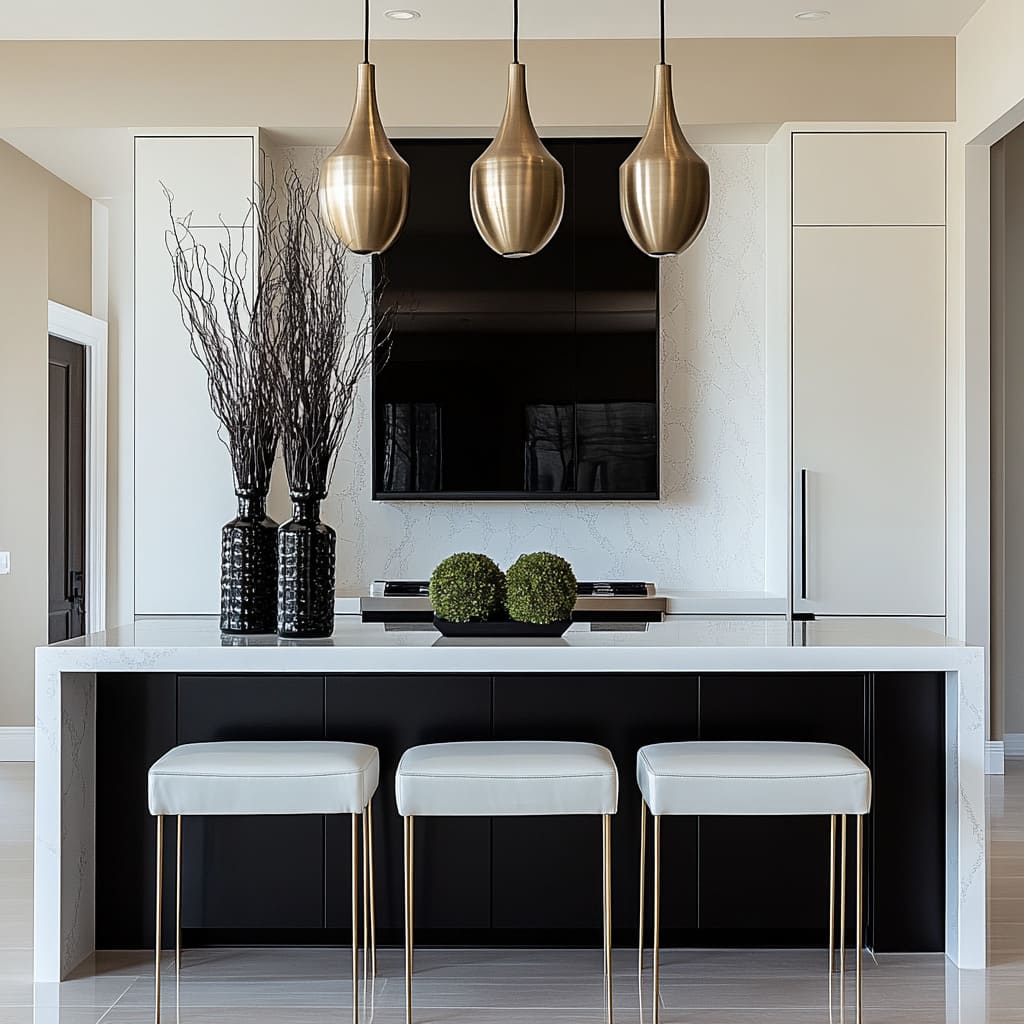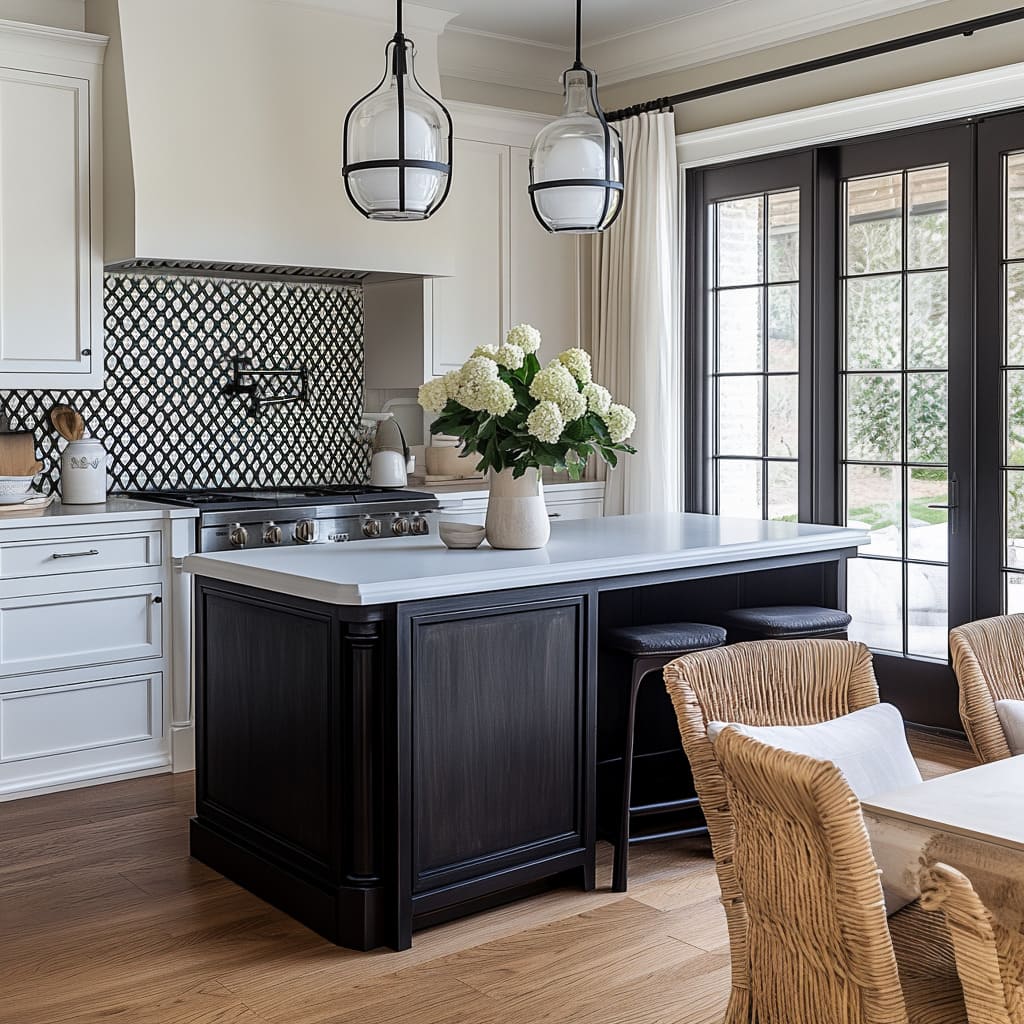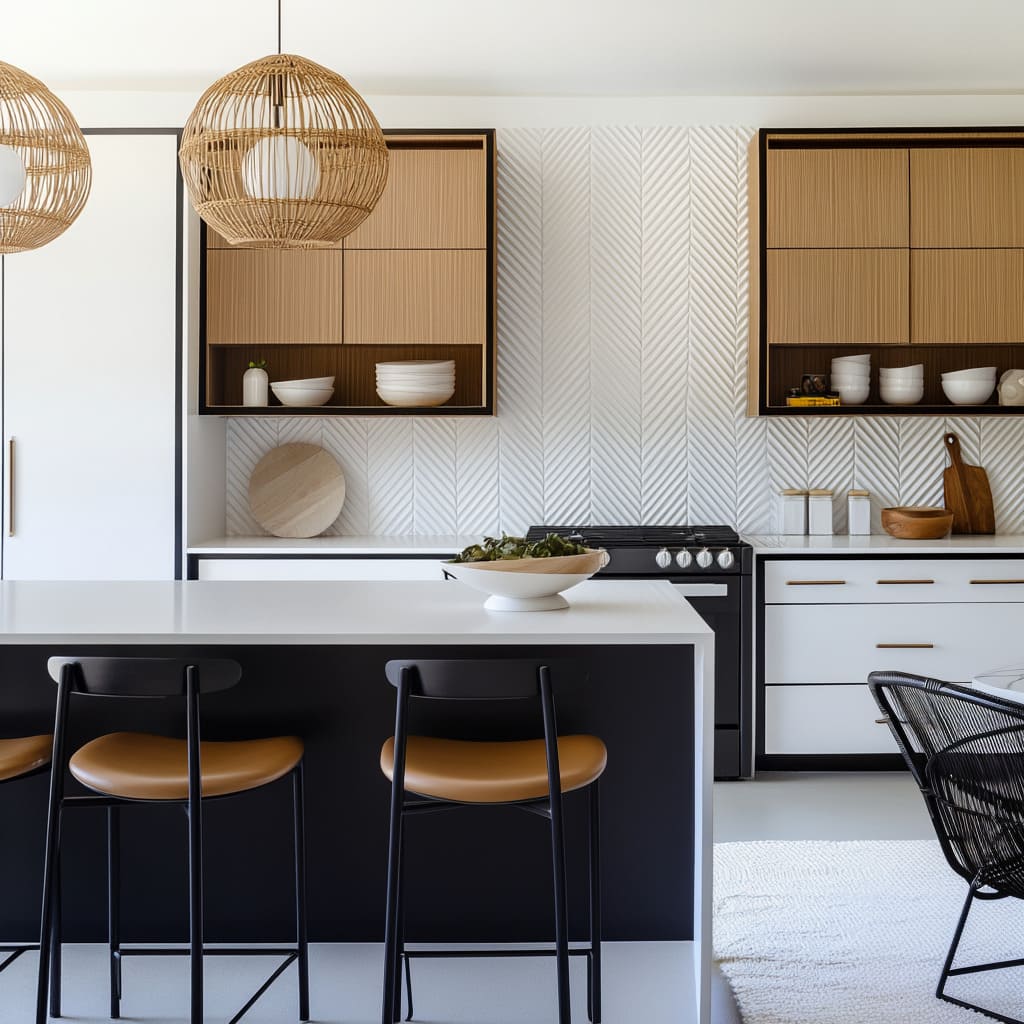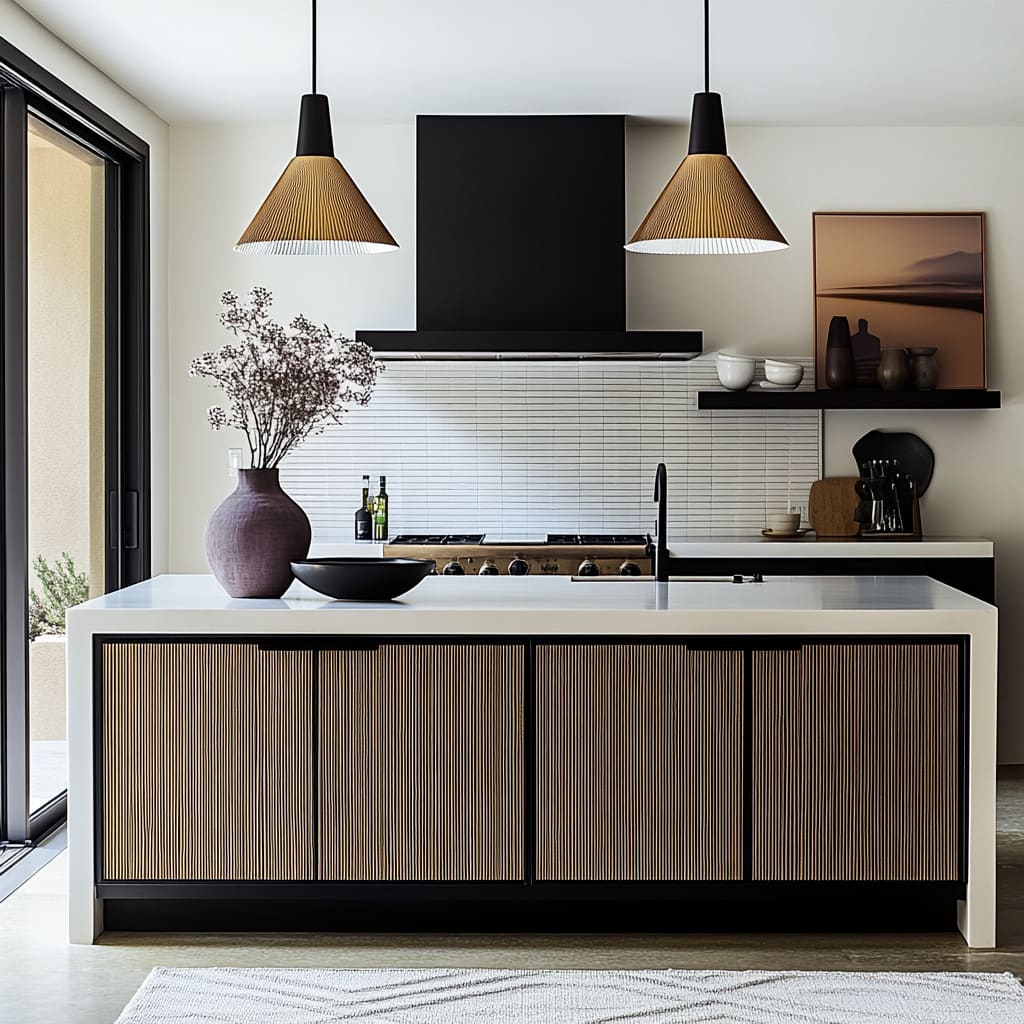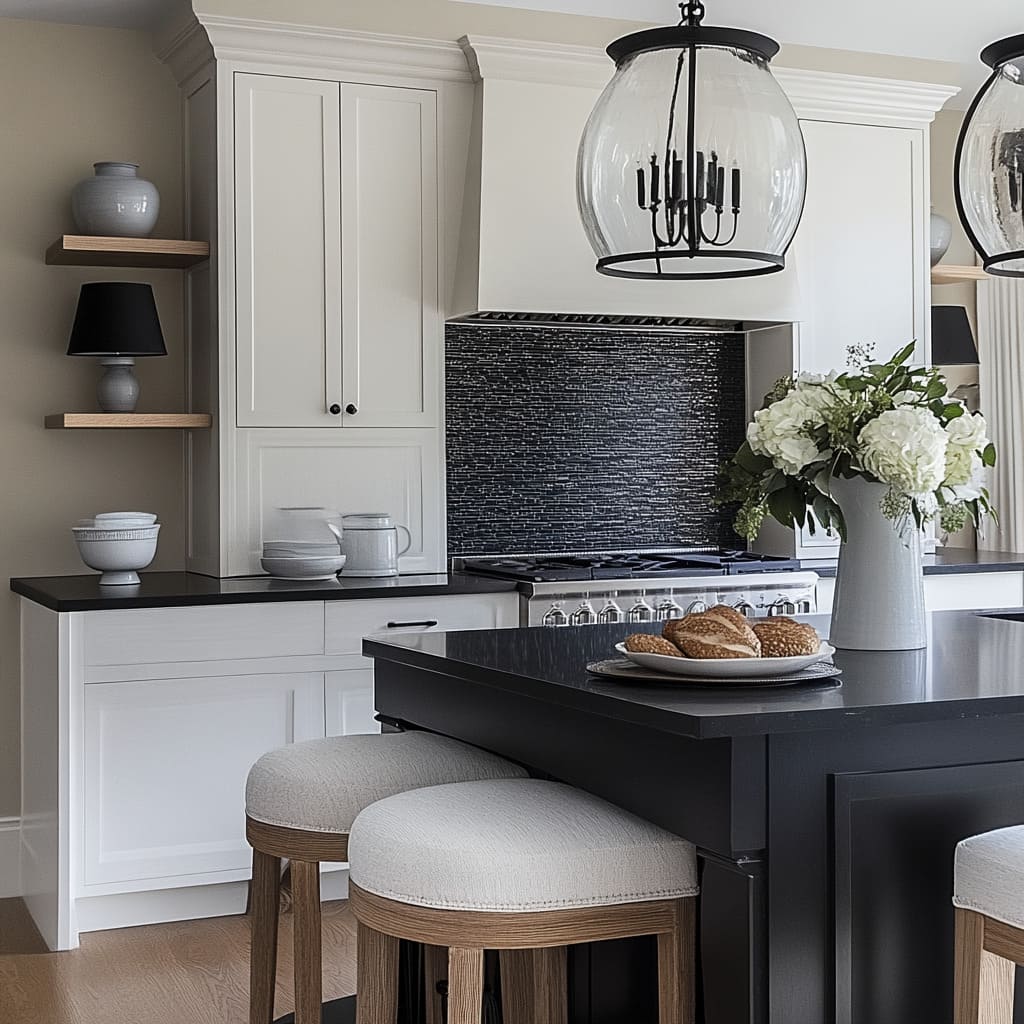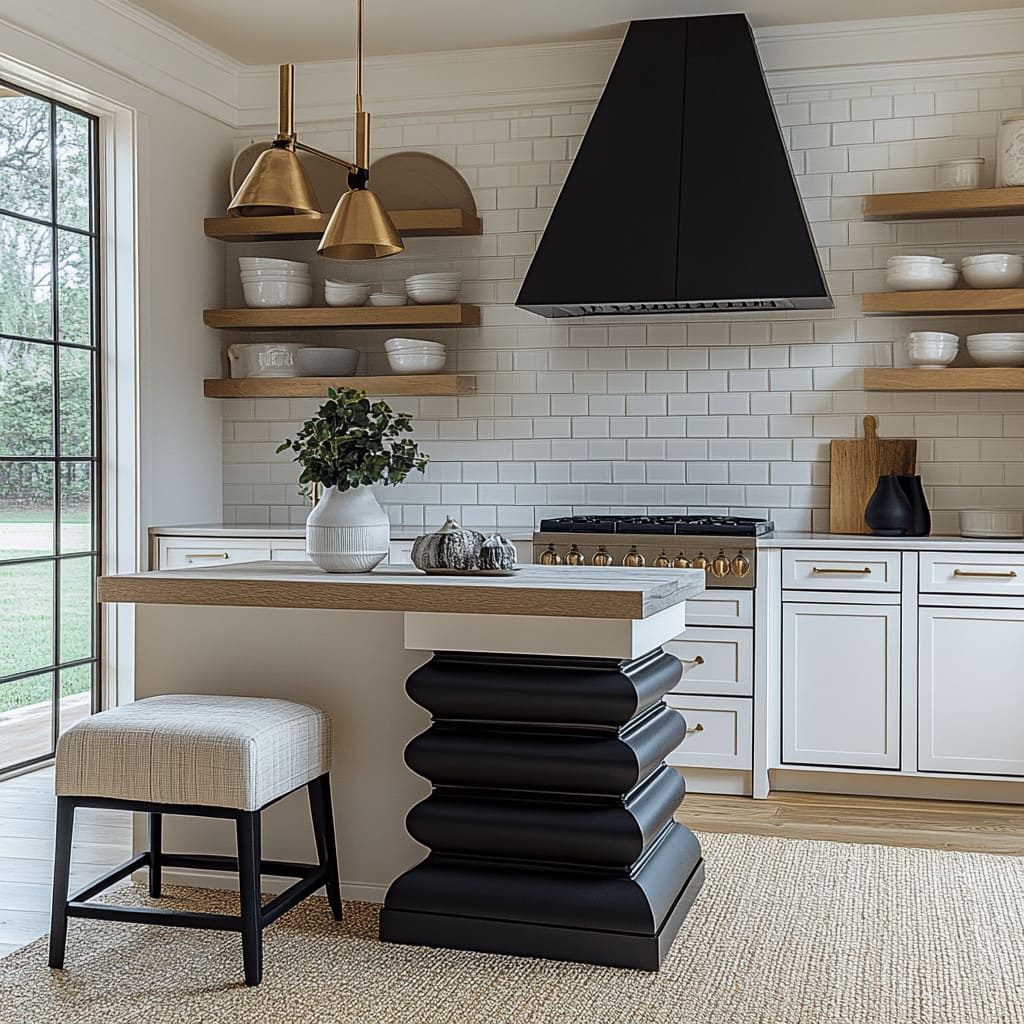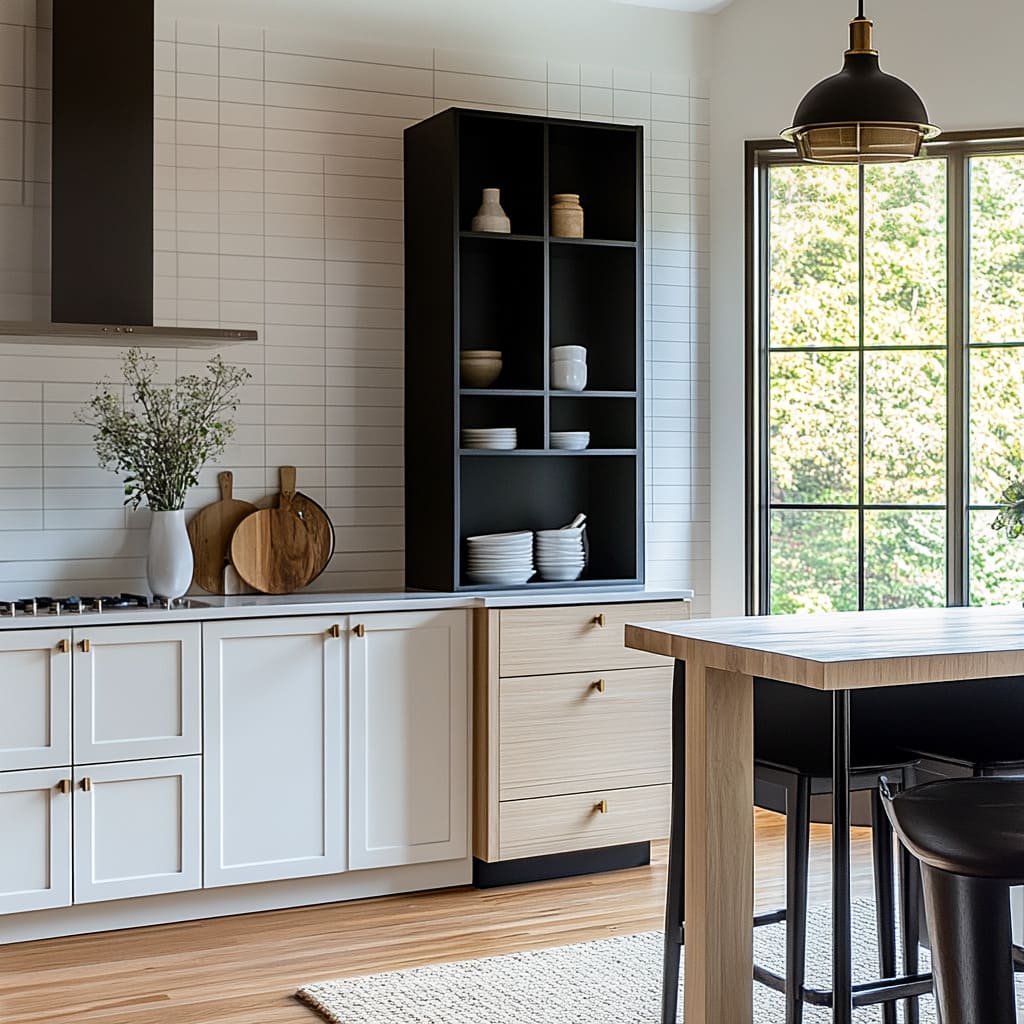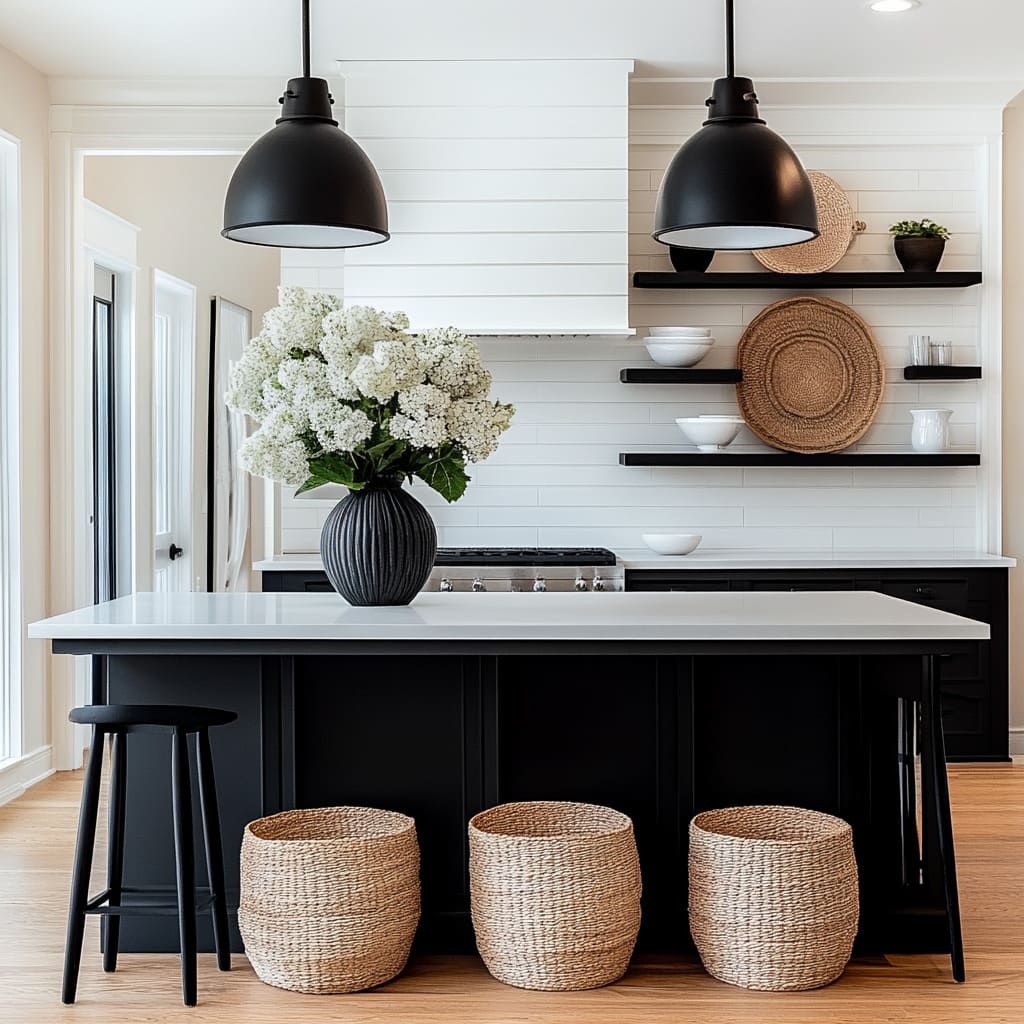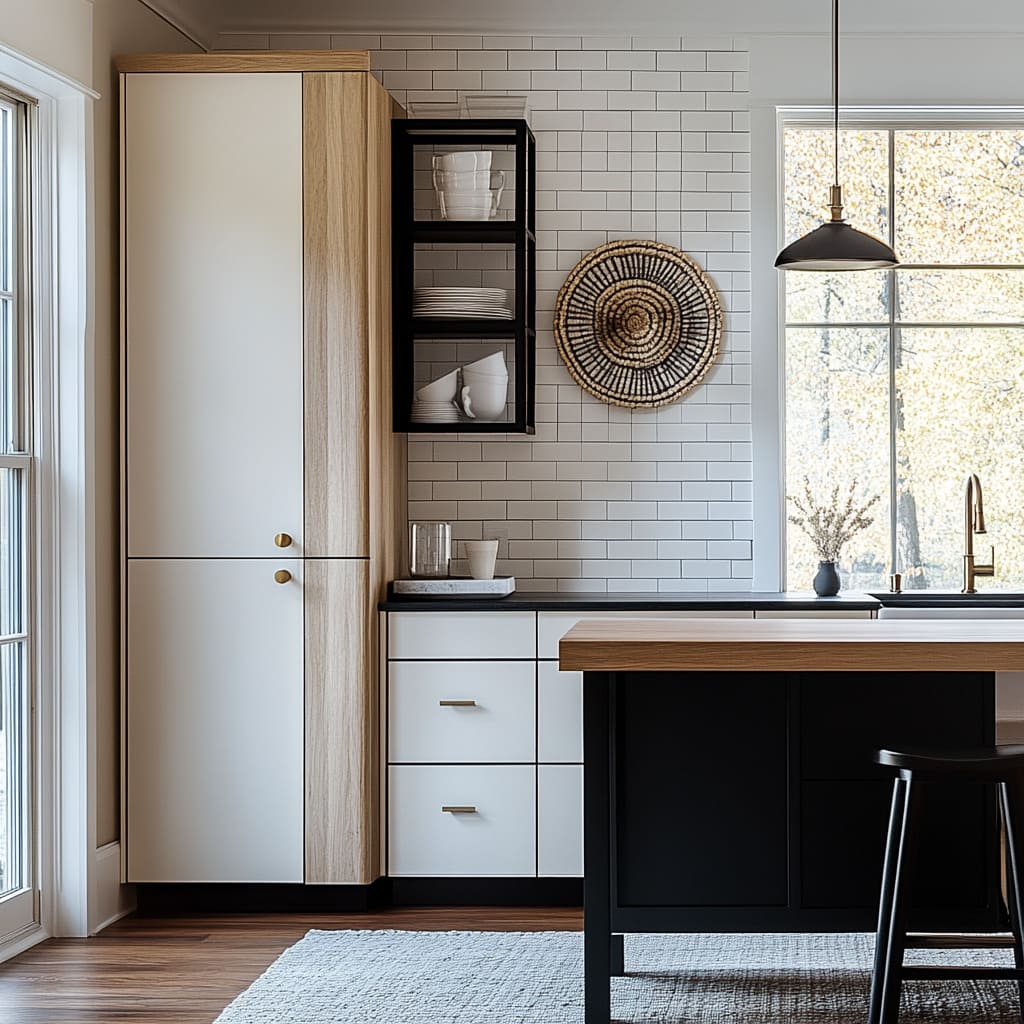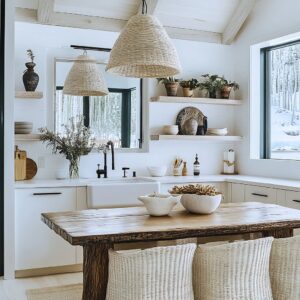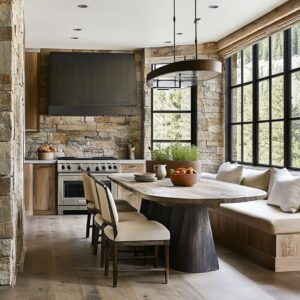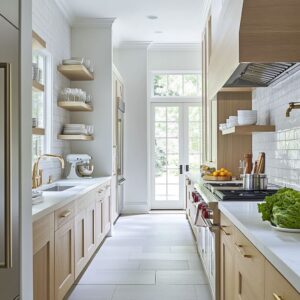Creating a creative and stylish black and white kitchen interior design is all about striking the perfect balance between bold contrasts and cohesive elements. These kitchens capture attention with their timeless appeal, offering a refined backdrop that can complement a variety of decor styles.
Whether you’re inspired by sleek modern layouts or a more traditional approach, the versatility of this color pairing allows for endless possibilities.
In this guide, we’ll explore black and white kitchen ideas that go beyond the ordinary, blending functionality with an aesthetic edge. From playing with textures to incorporating subtle accents, these insights are designed to help you craft a space that feels both inviting and visually captivating.
With careful planning and attention to detail, a black and white kitchen can easily become the highlight of any home, reflecting sophistication and creativity.
Leveraging Contrast as a Design Tool
Contrast forms the backbone of black and white kitchen design, transforming a simple space into a visually engaging and cohesive interior. This timeless pairing allows designers to highlight key features while maintaining a sense of balance.
The interplay of these opposing tones offers an opportunity to craft bold focal points and harmonious transitions throughout the room.
One of the most effective approaches is to use white kitchen cabinets with black countertops, creating a balanced visual hierarchy that draws the eye upward while grounding the design. This combination allows each surface to shine individually while working in unison to frame the overall aesthetic.
Similarly, pairing black island bases with white countertops achieves a grounded focal point, anchoring the room and adding depth to the layout.
For spaces where stark contrasts may feel overwhelming, incorporating gradual transitions can soften the effect without losing its dramatic appeal. Textured backsplashes, subtle gray gradients, or even natural stone accents introduce a sense of dimension, creating a smoother flow between black and white elements.
This technique works particularly well in compact kitchens, where maintaining a light and open ambiance is crucial.
To achieve harmony, restraint is key. Limiting additional accent colors ensures the focus remains on the contrast between black and white.
This intentional simplicity allows the design to feel cohesive and avoids unnecessary visual clutter. Balancing vertical surfaces, like cabinetry and walls, with horizontal planes such as floors and countertops, ensures the room maintains an even distribution of light and color, preventing any single element from dominating the space.
By strategically leveraging the timeless power of contrast, black and white kitchens can exude sophistication while remaining functional and inviting. This design approach underscores the importance of balance and intentionality, ensuring a striking yet harmonious kitchen environment.
Textural Layering for Depth
Incorporating texture is an essential aspect of creating depth and character in a black and white kitchen design. Without thoughtful layering, the bold contrast of black and white surfaces can sometimes feel stark or overly minimal.
Designers turn to tactile elements and mixed finishes to add visual interest, balance, and a sense of warmth to these spaces.
Tactile surfaces, such as ribbed panels, slatted wood, or chevron-patterned backsplashes, are key tools for enhancing the dimensionality of a kitchen. These details introduce subtle shadows and highlights, making flat surfaces come alive.
For instance, a chevron-patterned backsplash can create dynamic movement behind the countertop while complementing the overall palette. Ribbed wood accents, whether on cabinetry or islands, add sophistication while softening the monochromatic scheme.
Combining matte and glossy finishes is another effective way to achieve balance and intrigue. Matte black cabinetry, which absorbs light, provides a grounded and refined aesthetic.
In contrast, glossy white countertops reflect light, brightening the room and introducing an airy feel. This interplay ensures the kitchen avoids appearing too heavy or too stark, achieving a harmonious equilibrium.
Natural materials are invaluable for bringing warmth and texture into the space. Woven pendant lights, wooden cutting boards, and rattan baskets provide organic contrasts to the sleek surfaces of black and white.
These elements break up the uniformity of the palette while adding a layer of coziness, making the space more inviting. Using natural textures also grounds the kitchen, adding depth without overwhelming the color scheme.
For a truly engaging design, layering textures in unexpected ways can make all the difference. Pairing matte black islands with ribbed wood accents or integrating a patterned backsplash behind smooth white cabinetry creates a sense of tactile intrigue.
These combinations prevent the design from feeling monotonous while ensuring that every element has its own distinct role in the overall composition Thoughtful textural layering transforms a black and white kitchen from visually appealing to truly dynamic, offering depth, warmth, and a touch of personality. By balancing textures with finishes, the space becomes a sophisticated interplay of light, shadow, and material, showcasing how contrast and texture can work hand-in-hand.
The Role of Open Shelving
Open shelving has become a hallmark of thoughtful kitchen design, offering both functional and decorative benefits. In a black and white farmhouse kitchen, these shelves act as a canvas for curated items that inject personality into the space while maintaining its cohesive color scheme.
Designers use open shelving to bring softness and warmth to the bold contrast of black and white interiors.
Functionally, open shelves provide a home for everyday essentials like glassware, ceramics, or cookbooks, making them easily accessible. However, they are also an opportunity for artful displays.
For instance, a collection of neutral-toned pottery, small potted plants, or understated metallic accents can break up the monochromatic palette while adding texture and interest. These carefully chosen elements create balance and avoid a purely utilitarian appearance.
Backdrops play a significant role in enhancing the aesthetic of open shelving. White subway tiles, shiplap, or even painted walls in muted tones are commonly used behind black shelves to emphasize contrast and structure.
This layered effect provides visual depth while maintaining the clean lines and simplicity that define a monochromatic kitchen. The interplay of textures, such as the smooth finish of tiles against the wood grain of shelving, adds subtle sophistication.
The deliberate use of contrast is another cornerstone of successful shelving design. Black shelves against white walls create a striking rhythm, drawing the eye upward and lending the space a modern yet grounded look.
Similarly, white shelves against a black wall bring a lighter, airier touch, ensuring the overall design does not feel too heavy or stark. This thoughtful placement of contrasting elements establishes a sense of harmony without sacrificing the boldness of the palette.
For an added layer of warmth, many designers recommend incorporating complementary materials like natural wood tones or soft metallics. Wooden bowls, cutting boards, or wicker baskets add an earthy touch, making the kitchen feel more welcoming.
Subtle metallic accents, such as brass or bronze, can introduce a refined shimmer without overwhelming the design. These additions ensure that open shelving does not feel like an afterthought but rather an integral part of the overall composition.
In essence, open shelving in black and white kitchens is much more than storage; it’s a platform for personalization and creativity. By mixing function with design, balancing contrast with warmth, and layering textures thoughtfully, these shelves contribute to a cohesive yet character-filled space that embodies both practicality and style.
Strategic Use of Complementary Colors
Introducing complementary colors into a monochromatic kitchen requires a careful and intentional approach. These tones should enhance the design, providing balance and personality without detracting from the striking contrast that defines a black and white kitchen accents theme.
Thoughtful use of additional hues can soften the starkness of black and white while enriching the visual appeal. Neutral complements like natural wood tones, muted grays, and warm beige are often incorporated into cabinetry, flooring, or small decor pieces.
These colors act as transitional elements, bridging the gap between the bold contrast of black and white. For example, wooden cutting boards, woven bar stools, or beige rugs add texture and warmth, preventing the space from feeling overly sharp or uninviting.
These subtle additions ground the design, making the kitchen feel welcoming and cohesive.
Incorporating bold accents can bring vibrancy to the design without overwhelming the main palette. A touch of greenery, such as potted plants, herbs in simple containers, or even hanging planters, adds a refreshing natural element to the kitchen.
Metallic finishes in brass, chrome, or matte gold—whether on cabinet handles, light fixtures, or decorative bowls—introduce a subtle sheen that elevates the aesthetic while maintaining the elegance of the black-and-white scheme. Similarly, hints of blue in wall art, ceramics, or small accessories can provide a soothing counterbalance.
The placement of complementary tones is as important as the colors themselves. Neutral or natural elements are often used on horizontal planes like flooring or countertops, where they create a visual base for the contrasting black and white tones above.
Bolder accents, on the other hand, are more effective as focal points. A striking green plant or a metallic pendant light draws attention to key areas of the design, adding depth and visual interest.
Designer advice often emphasizes restraint in using complementary tones. While they can add dimension, introducing too many colors risks diluting the impact of the black-and-white palette.
Each additional hue should have a clear purpose, whether it’s adding warmth, texture, or a pop of vibrancy. For instance, a few strategically placed wooden accessories can soften the space, while a single vibrant artwork can act as a focal point without overwhelming the kitchen’s clean lines.
In conclusion, complementary colors in a black-and-white kitchen are not just decorative but integral to achieving balance and character. By blending neutral tones, natural textures, and carefully selected accents, designers can craft a space that feels dynamic, cohesive, and effortlessly stylish.
These thoughtful choices ensure that the complementary colors enhance the overall design, maintaining the bold story of black and white.
Designing Focal Points
A well-designed black and white kitchen thrives on thoughtful focal points that draw the eye and create layers of visual intrigue. These standout features not only anchor the room but also elevate the overall design, adding depth and personality to the space.
By blending bold design choices with a cohesive palette, focal points can transform a functional kitchen into a stylish centerpiece.
Feature islands are a go-to element for creating impactful focal points. Incorporate unique details like rounded corners, ribbed paneling, or contrasting finishes to make the island stand out.
For example, a black island base with ribbed detailing, topped with a pristine white countertop, becomes both a visual and functional centerpiece. To enhance its presence, dramatic pendant lighting above the island can create a striking statement while ensuring practicality.
Statement backsplashes add texture and character, often becoming the backdrop that defines the kitchen’s aesthetic. Chevron or herringbone patterns, intricate tile motifs, or bold monochrome designs are excellent choices for injecting personality into the space.
These backsplashes not only add visual interest but also frame the surrounding cabinetry and appliances, ensuring the design feels cohesive. Custom range hoods are another effective way to introduce a focal point.
A sleek black hood with geometric lines or a softly curved design can draw the eye upward, providing architectural interest. Placed against a backdrop of white or textured tiles, the hood becomes a central feature that adds balance and sophistication to the room.
In the broader context of black and white kitchen theme ideas, focal points should be used strategically to break up large sections of monochromatic surfaces. Contrasting finishes, textures, or shapes help these elements stand out without clashing with the overall design.
For instance, a dramatic island or backsplash in black creates depth and contrast against surrounding white cabinetry. By thoughtfully incorporating focal points, you can guide the flow of the space and highlight its best features.
The key is to ensure that these standout elements contrast sufficiently with their surroundings, creating interest without overwhelming the design. This layered approach ensures a dynamic kitchen that feels both visually engaging and highly functional.
Lighting as a Design Element
Lighting plays a crucial role in bringing a black and white kitchen to life, transforming it from a functional space into a design statement. The right lighting scheme enhances contrast, highlights textures, and emphasizes key focal points, making it an integral part of the overall aesthetic.
Layered lighting is the foundation of a well-lit kitchen, combining functional, ambient, and decorative elements. Pendant lights, especially those crafted from bold materials like woven rattan or sleek metal, serve both a practical purpose and an artistic one.
For instance, in a white kitchen with black light fixtures, the contrast creates a striking visual while maintaining a cohesive design. These fixtures act as anchors, tying the lighting to the overall color palette while adding a modern edge.
Accent lighting, such as LED strips under cabinets or within open shelves, provides an elegant way to highlight textures and details. These subtle light sources create depth and dimension by casting soft glows on backsplashes, countertops, and decor items.
LED lighting is particularly effective in enhancing patterns or finishes, such as the glossy tiles of a backsplash or the ribbed surface of a cabinet panel. Matte black light fixtures, whether in sconces, chandeliers, or track lighting, offer a contemporary touch that complements the monochromatic theme.
They pair seamlessly with white surfaces, creating a balanced interplay of light and shadow. These fixtures can also serve as bold focal points when strategically placed, such as above a kitchen island or dining nook.
Lighting should always be designed with intention. Use directional lighting to emphasize key areas like the kitchen island or a feature backsplash.
For instance, adjustable spotlights can direct attention to textured surfaces, enhancing their visual impact. This approach ensures that every lighting element contributes to the room’s design narrative.
By combining layered lighting, accent illumination, and statement fixtures, a black and white kitchen gains both function and style. Thoughtful lighting choices not only enhance the kitchen’s aesthetic appeal but also create a welcoming and dynamic space.
Playing with Proportions
Proportions are an essential design tool in black & white kitchens, shaping the balance and flow of the space while emphasizing key features. Whether through symmetry or intentional asymmetry, playing with proportions can create a visually compelling and harmonious environment.
Symmetry and balance provide a clean and polished aesthetic, perfect for those seeking a modern or formal design. Aligning cabinetry, lighting, and fixtures ensures the space feels orderly and cohesive.
For instance, centering pendant lights above a kitchen island or framing the range hood with evenly spaced shelves creates a sense of structure. This approach works especially well in open-concept designs, where the kitchen becomes the visual anchor of the room.
On the other hand, asymmetry adds interest and a casual, contemporary vibe. By varying the layout of shelves, decor, or even island seating, you can break up the uniformity while maintaining overall harmony.
For example, a single floating shelf on one side of the range hood paired with open shelving on the other creates a dynamic look without feeling chaotic. Similarly, offsetting island seating adds a playful, lived-in feel.
Proportional balance is the key to success, no matter the approach. Symmetry often lends itself to a structured and classic design, while asymmetry feels more relaxed and creative.
Designers often combine the two, ensuring some elements—like lighting or cabinetry—stay symmetrical while introducing asymmetry in decor or seating to keep the space visually engaging. By thoughtfully considering proportions, black and white kitchens can achieve a sense of balance and personality that makes the design both functional and stylish.
The right interplay of symmetry and asymmetry creates a dynamic layout that feels well-considered and inviting.
Small Details with Big Impact
In a kitchen where black and white dominate the design, it’s the small details that often make the biggest difference. Thoughtfully chosen accents and finishes can elevate the overall aesthetic, adding depth, warmth, and personality to the space.
These subtle touches ensure that the design feels complete and uniquely tailored.
Hardware and fixtures play a crucial role in establishing contrast and cohesion. Black hardware on white cabinets, or metallic finishes like brass or chrome, creates a sleek, polished look.
Brass handles or faucets, in particular, add a subtle warmth that balances the starkness of a monochromatic palette. The shape and texture of these elements—whether minimalist or ornate—can subtly enhance the overall design, drawing the eye without overpowering the space.
Decorative accents bring in personality while maintaining harmony with the kitchen’s core design. Items like natural wood cutting boards, ceramic bowls, or simple glass vases introduce texture and interest without disrupting the monochromatic theme.
Incorporating neutral tones into black and white kitchen decor adds depth and a sense of continuity, ensuring these details feel like part of the design rather than an afterthought.
Greenery is an effortless way to refresh a monochromatic scheme. A small potted plant on a windowsill or fresh-cut flowers in a vase on the island provide a natural, organic element that softens the overall look.
These pops of green not only bring life to the space but also contrast beautifully against the clean lines and bold contrasts of black and white.
When selecting small details, it’s important to choose elements that enhance the space without competing for attention. Every piece, from the hardware to the decor, should complement the kitchen’s key features, contributing to a cohesive and inviting atmosphere.
These seemingly minor choices often carry the design to the next level, proving that the little things truly do matter.
Flooring and Ceiling Design
The flooring and ceiling in a black and white kitchen are subtle yet essential components of the overall design. While these elements often act as supporting features, they play a critical role in tying the space together and enhancing its visual harmony.
Thoughtfully chosen materials and details can elevate the kitchen while keeping the focus on the main elements.
For the black and white kitchen flooring, extending the monochromatic palette to the ground creates continuity and balance. Light wood floors, for example, add a touch of warmth and contrast subtly with black cabinets or islands.
Alternatively, neutral tiles in shades of white or soft gray offer a clean, minimalistic base that complements the bold contrasts above. Patterns like herringbone or large-format tiles can add subtle texture, preventing the floor from feeling too plain or utilitarian.
The ceiling, often overlooked, offers an opportunity to enhance the kitchen’s vertical dimension. Subtle details like crown molding lend a touch of sophistication, framing the space without overpowering it.
Recessed lighting ensures even illumination while maintaining a streamlined appearance. For kitchens with a farmhouse or rustic influence, a shiplap ceiling introduces texture and character, harmonizing with the black and white theme while adding a hint of charm.
Both flooring and ceiling elements should remain understated, allowing the bold contrasts of cabinetry, backsplashes, and islands to take center stage. However, their finishes and textures are vital in supporting the design.
A matte finish on wood floors can create a softer, more inviting feel, while a glossy tile reflects light, enhancing the brightness of the space. Ultimately, the flooring and ceiling work together to ground the kitchen while framing its key design elements.
By choosing materials and finishes that align with the monochromatic palette, these features can subtly enhance the overall aesthetic, proving that even the most understated details are essential to a cohesive design.
Innovative Combinations and Schemas
The beauty of black and white kitchen design lies in its versatility, allowing for endless opportunities to explore creative combinations and layouts. By thoughtfully layering colors, textures, and materials, you can transform a simple palette into a multi-dimensional, functional, and visually captivating space.
Monochromatic layering is a subtle yet effective way to add depth without introducing additional colors. By incorporating varying shades of black, white, and gray, designers create a rich, layered look that feels dynamic yet cohesive.
For instance, light gray walls can bridge the gap between white cabinetry and black countertops, softening the overall contrast while maintaining the integrity of the monochromatic scheme.
Mixed materials bring a tactile dimension to the design, combining contrasting finishes and textures for an engaging effect. Pairing matte black cabinetry with glossy white countertops introduces a sleek interplay of light and shadow, while adding elements like natural wood or metal accents brings warmth and variety.
For example, a black island with wooden slat paneling or a polished metal backsplash offers a multi-dimensional look that feels modern and balanced.
Zoning with color is another powerful tool in black & white kitchen ideas, allowing designers to create visual separation between different areas of the kitchen. Black cabinetry on the lower level paired with white cabinets above not only adds visual interest but also draws the eye upward, making the space feel taller.
Differentiating the kitchen island with a contrasting material or finish, such as a wood-clad base or a pop of light gray, can further emphasize its role as a focal point.
The success of these combinations lies in their intentionality. Each material, finish, and color placement should serve a purpose, whether it’s adding depth, defining zones, or creating contrast.
By blending these elements thoughtfully, designers can turn a straightforward black-and-white palette into an artistic expression of style and functionality. This approach ensures that the kitchen feels unique, cohesive, and tailored to both aesthetic preferences and practical needs.
Conclusion
A successful black-and-white kitchen design balances bold contrast, rich textures, and thoughtful details. By incorporating non-trivial elements like mixed finishes, complementary tones, and carefully curated focal points, designers can create spaces that feel both stylish and functional.
The key lies in layering textures, emphasizing proportions, and integrating subtle natural and metallic elements to add warmth and depth to the stark palette. Ultimately, the design must harmonize all elements, ensuring the space feels cohesive and timeless.

